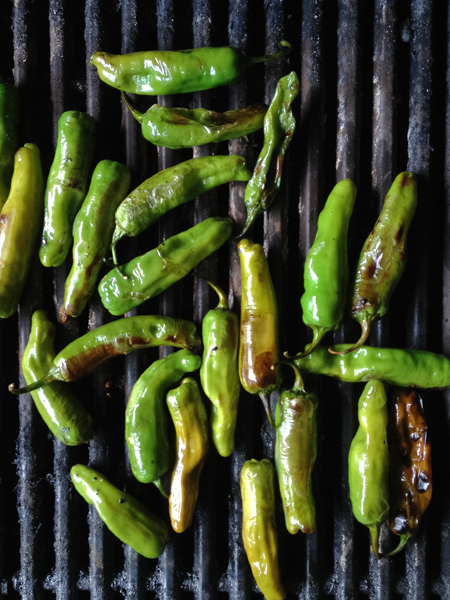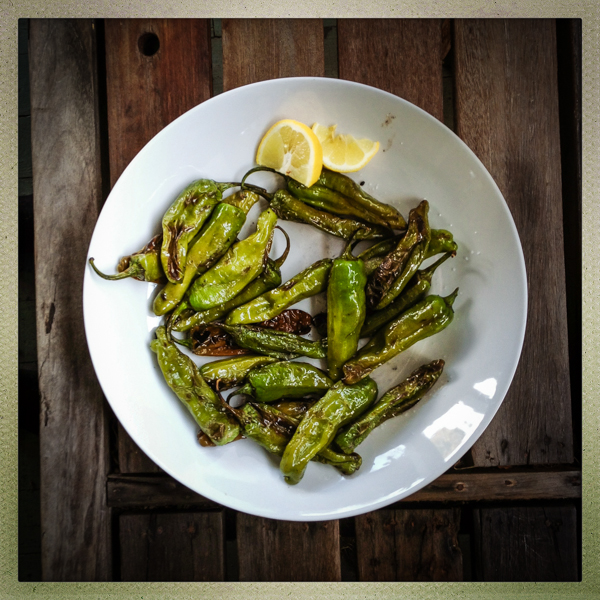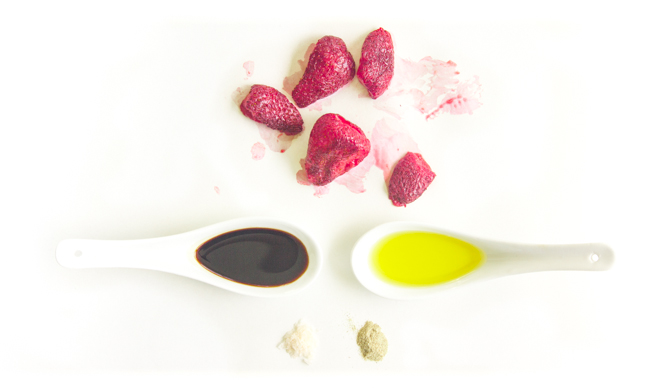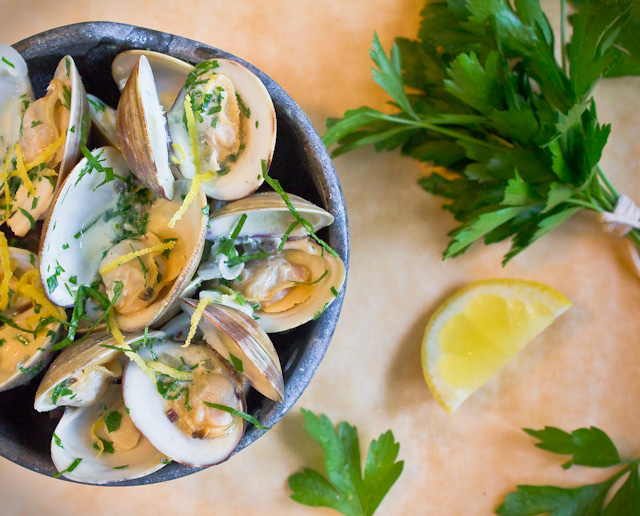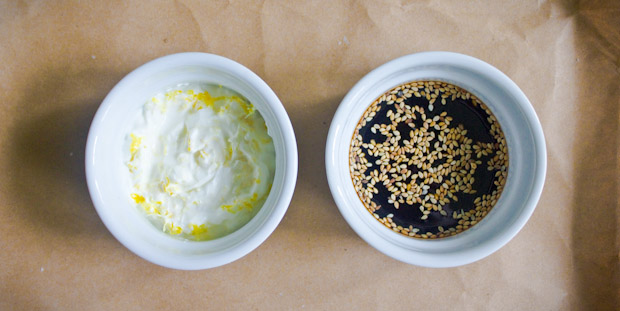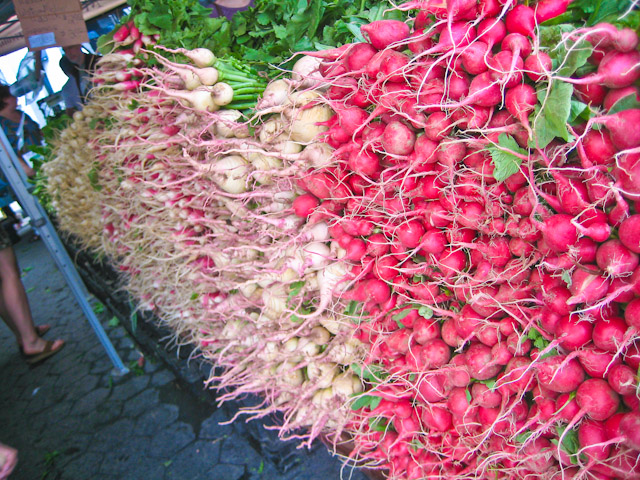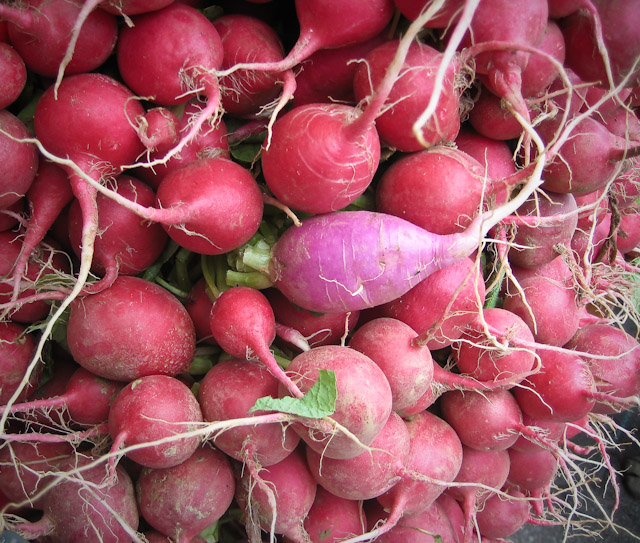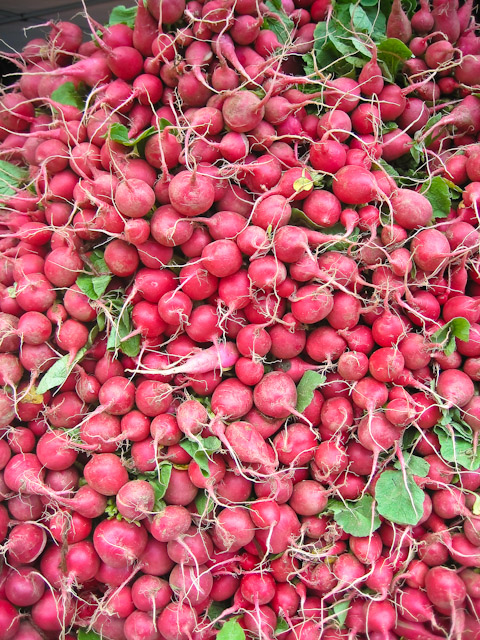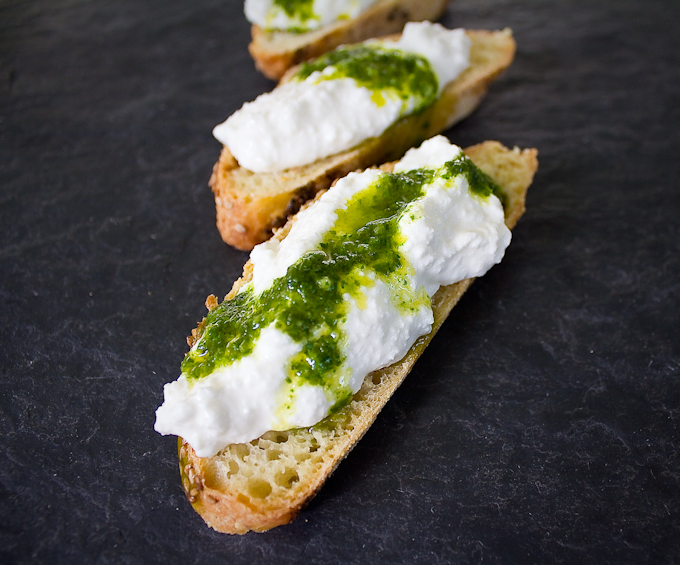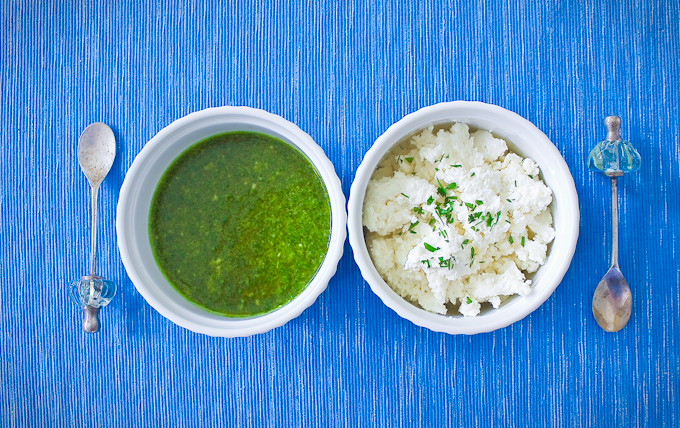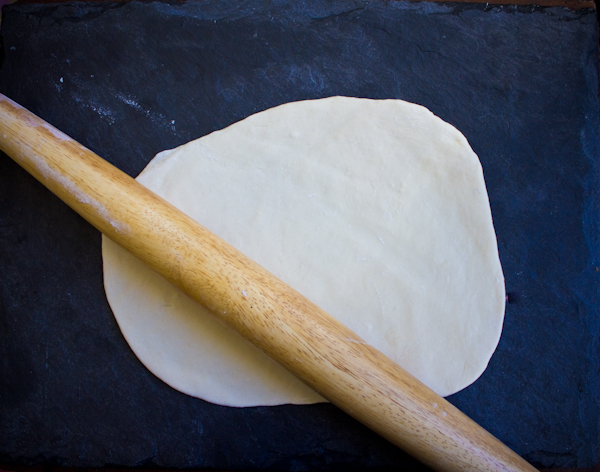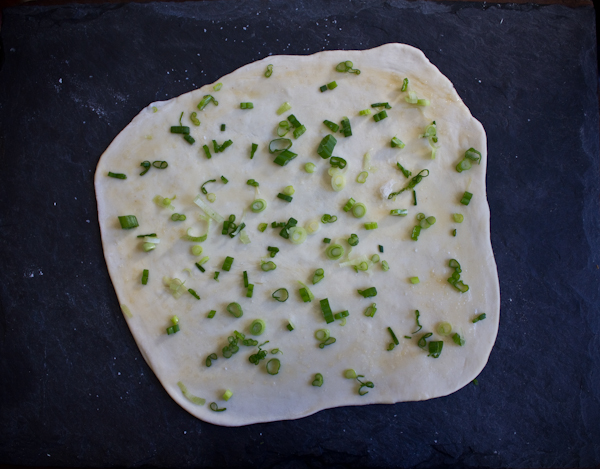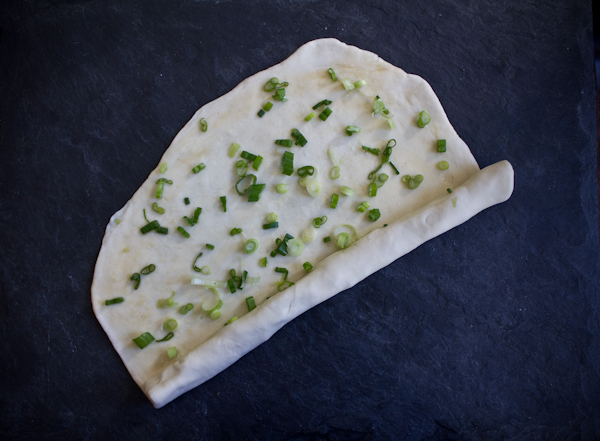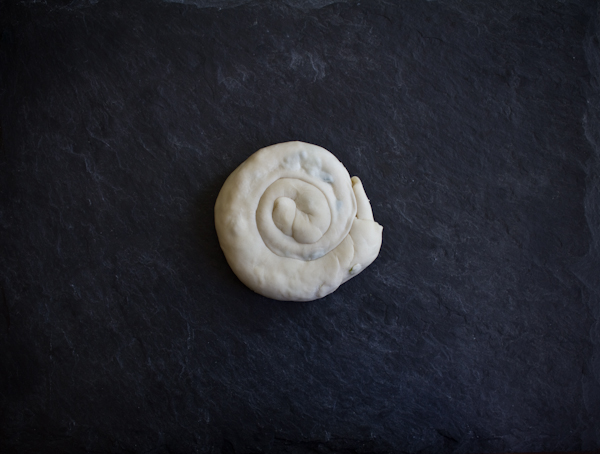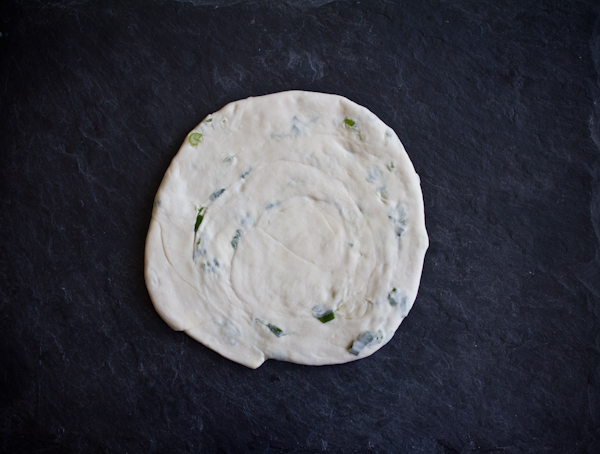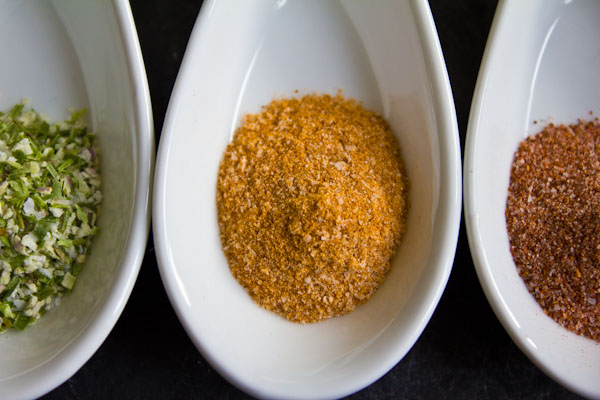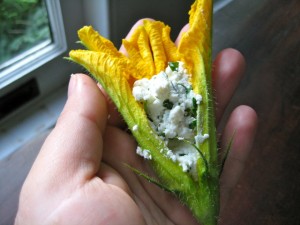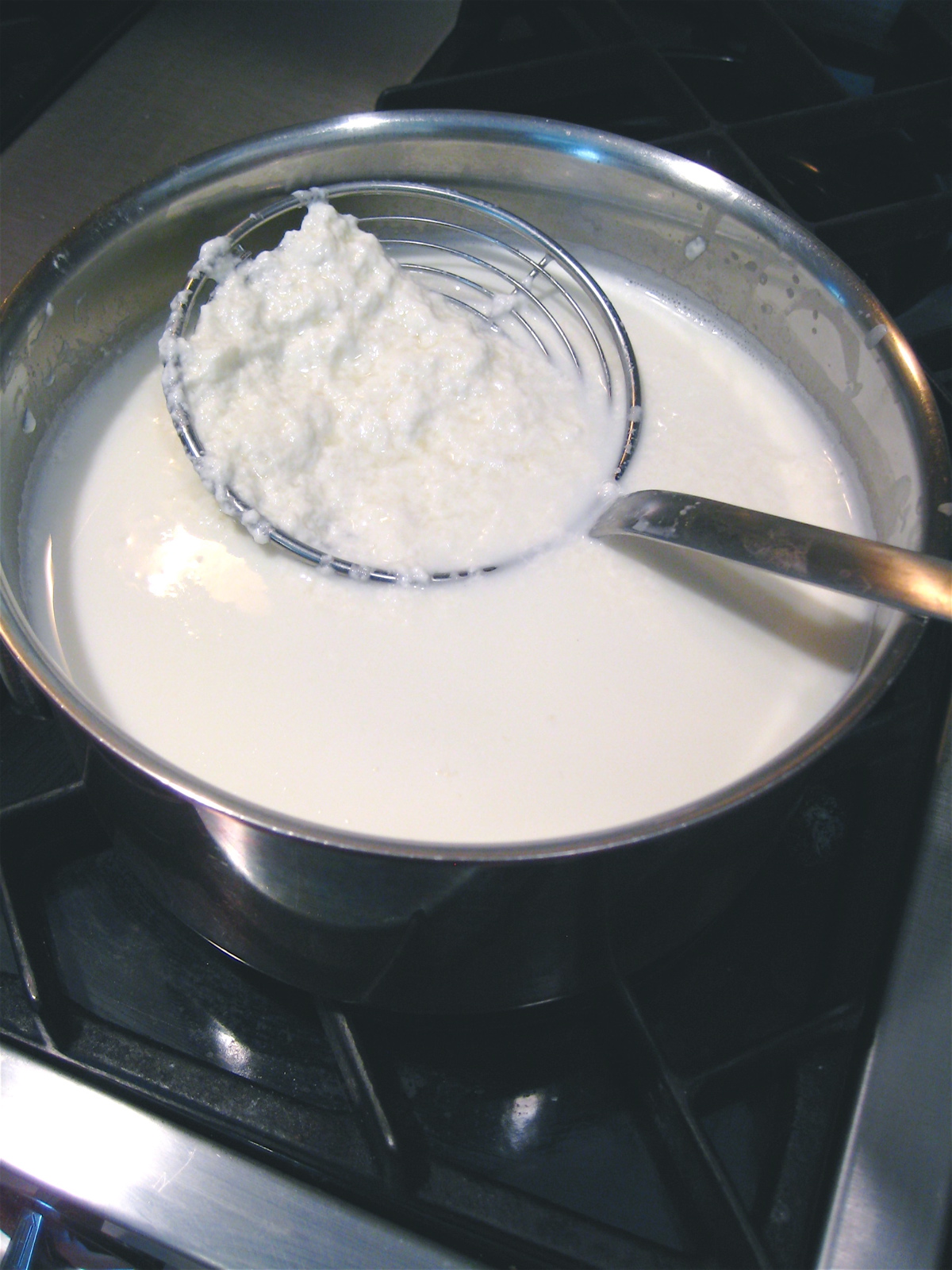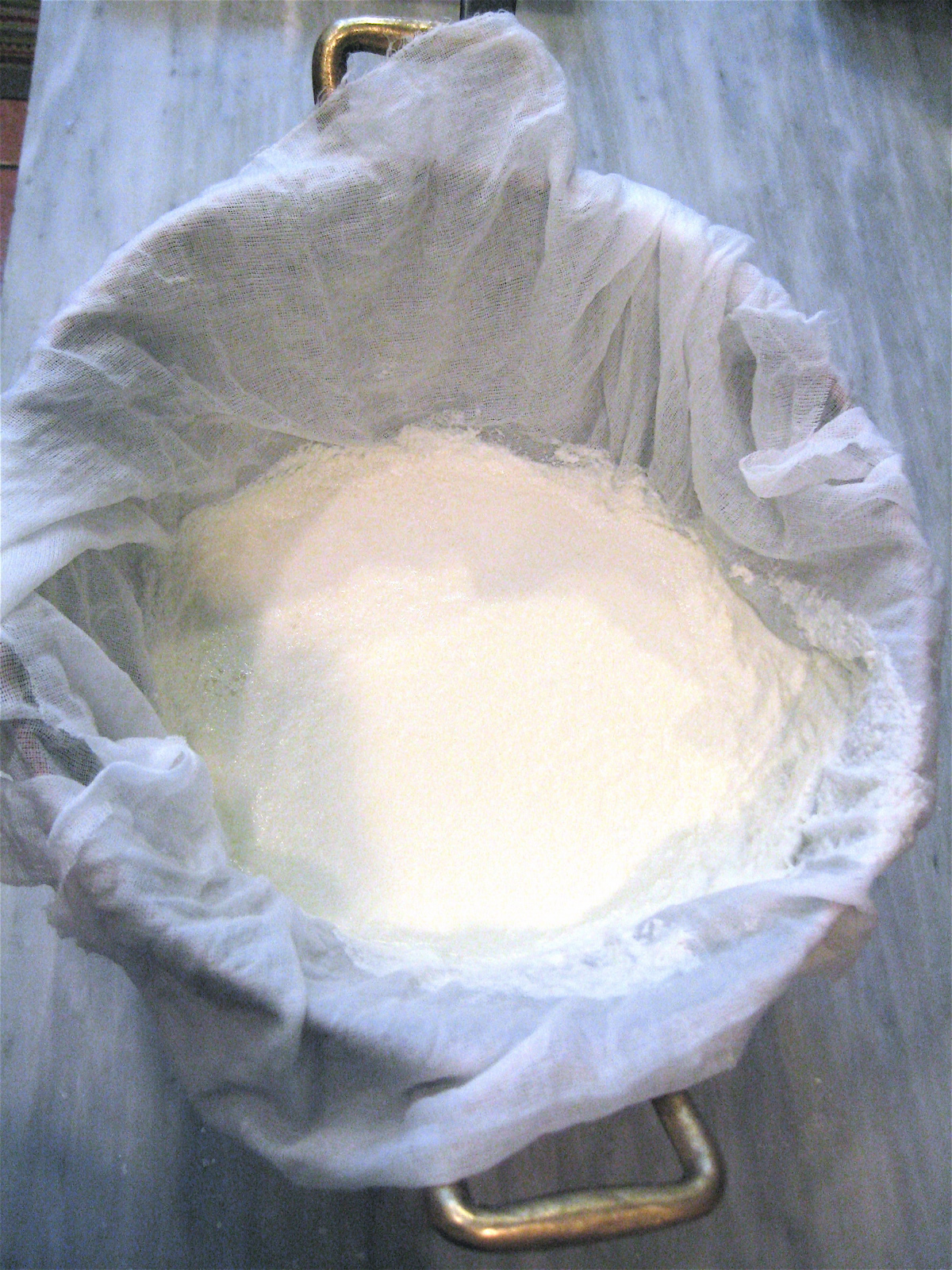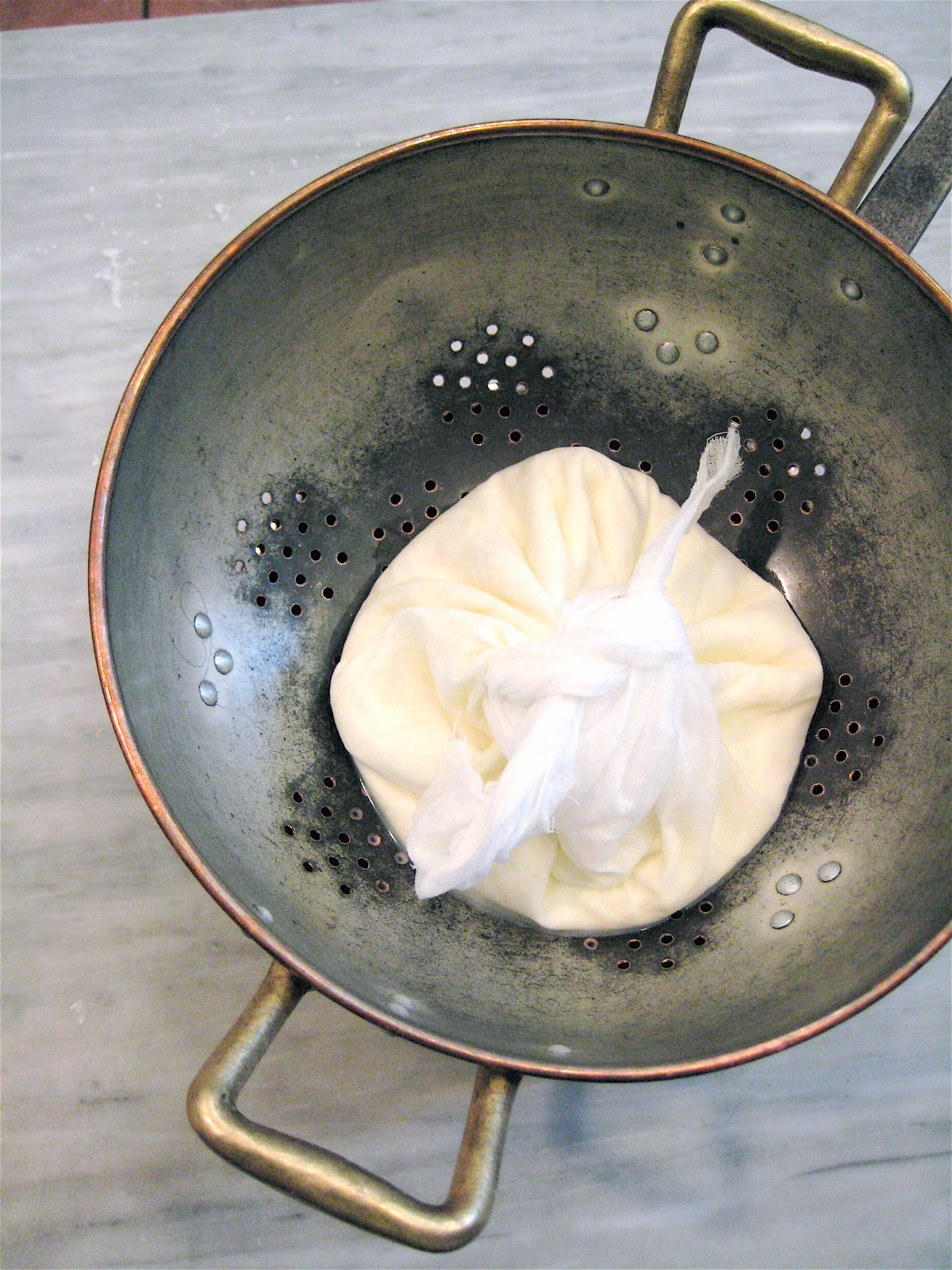This mild pepper from Japan has become quite the culinary rage over the last handful of years. I first had them as a snack in a benefit cooking master class for Slow Food NYC, and have been growing them in my garden ever since. Shishito peppers are slender, bright green, and about the length of your index finger. They are super flavorful yet mild, with about one in a dozen delivering a memorable amount of heat. Consider it a party game. I love serving a huge platter of grilled shishitos with cold cocktails at the start of a big summer dinner party. Quick, easy, impressive, slightly unusual and pretty much universally adored--there should be no hesitation in adding these to the menu. Padron peppers can be prepared and served the same way, but will be hotter in flavor overall. We are in high shishito season right now, so keep an eye out at the market, and definitely grow your own next summer.
| ||||||||||||||||||||||
I love rhubarb. I love it for it's old fashioned vibe. I love it for it's color, striking tartness, and even for it's moderate shelf life. I also love it for showing up so darn early in the spring and sticking around for several months. And I too was at first intimidated by those long, irregular-shaped, tough magenta stalks at the market. I actually overheard a conversation at our market up here recently, where a woman who had just bought a weekend house near the Delaware discovered she had huge decades-old rhubarb plants growing on her property. However she didn't know when it was time to pick them. Nor did the young woman working the farm stand, so I jumped in with what I knew. She had been waiting for them to turn red, ripen, to pick. I explained that some heirloom varieties, have very little red, and the stalks can range from thin to the thicker more uniform we're used to seeing in grocery stores. I generally go by feel, but you can harvest stalks when between ten and fifteen inches long, avoiding letting them go too long and become tough, dry or woody. Once you get your rhubarb back you your kitchen, from yard or market, they really are one of the most simple fruit to prepare. Make sure all traces of the leaves are trimmed off, as they are not edible. Rhubarb have a bad rap for being stringy, as in celery stringy, but as long as they are cut in small pieces before cooked, the strings will not be a nuisance. For good measure, or habit, I tend to peel two or three strings off each stalk, from end to end, but not too much, as you are also peeling off any of the great magenta color. Wash the stalks well and then cut into slices between an half inch and an inch thick. You can then roast the pieces, throw them in to brighten up a rich stew, or as I do most often, simmer them down to a quick rhubarb puree or sauce. Pack the rhubarb into a sauce pan or small pot that holds the pieces sort of snugly. Add enough water to come up about 3/4 of the way up the sides of the slices, and simmer over a medium-low heat, until the rhubarb has broken down and is tender. Add more water if the mixture seems to be getting to dry or risking burning at all. When finished you can mash it up a little to have a sauce with more texture, or use a food processor, blender or immersion blender to give you smoother final product. If you are looking to use the sauce as a topping by itself, add about a tablespoon of sugar per large stalk of rhubarb when simmering down, or another classic way to cut rhubarb's intense sourness is to add at least 1 part strawberries for every 3 parts rhubarb when starting the sauce. Taste when finished and adjust sweetness if necessary. Vanilla beans, ginger, orange, cinnamon, almost all berries and apples are all great additions as well. Make a big batch. Eat it warm or ice cold. Spoon it over ice cream, blend it into cream cheese, swirl it in yogurt or oatmeal, drizzle it over a wedge of Stilton or duck or game meats, whisk it into your vinaigrette, blend it with ice for your margarita. Really, what other fruit, the northeast no less, is quite so versatile? | ||||||||||||||||
Something to do with asparagus right now...(and what I'm having for dinner.)
| ||||||||||||||||||||||
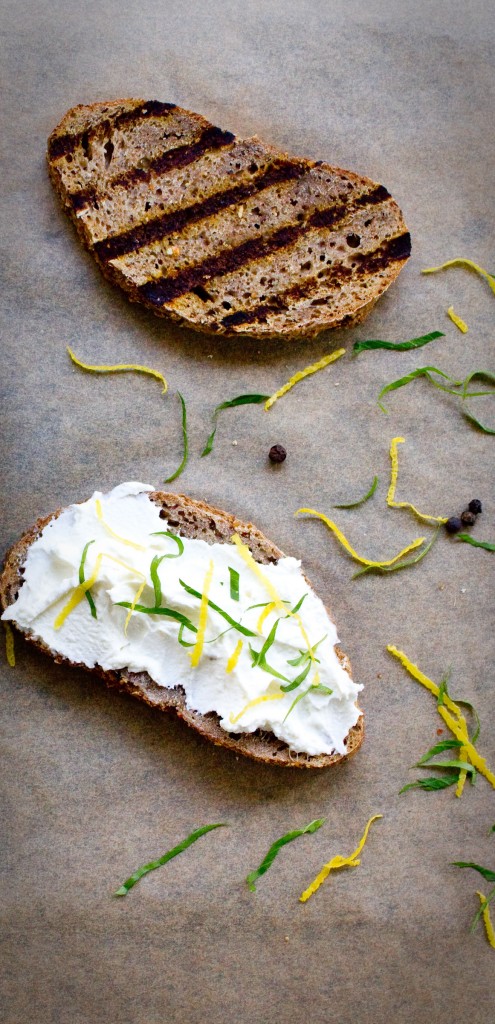 Help! Thanksgiving is 72 hours away and while you have been dog-earing cookbooks for weeks, shopped the weekend before, and even managed to avoid the elbow to your shoulder by the feisty octogenarian who was going to in NO WAY let you have the store's last quart of whipping cream (this actually happened to me in graduate school), you just realized that you totally forgot to plan for something to occupy your relatives while you get the food ready for the table. And so inevitably they will end up equally split between hovering directly in your path in your tiny overheated kitchen or rehashing the recent election and whatswrongwiththiscountry requiring a last-minute rearrangement of the pilgrim place cards. Again. Help! Thanksgiving is 72 hours away and while you have been dog-earing cookbooks for weeks, shopped the weekend before, and even managed to avoid the elbow to your shoulder by the feisty octogenarian who was going to in NO WAY let you have the store's last quart of whipping cream (this actually happened to me in graduate school), you just realized that you totally forgot to plan for something to occupy your relatives while you get the food ready for the table. And so inevitably they will end up equally split between hovering directly in your path in your tiny overheated kitchen or rehashing the recent election and whatswrongwiththiscountry requiring a last-minute rearrangement of the pilgrim place cards. Again.Oh, right, and you have overzealously planned an almost too complicated multi-course meal culled from your favorite food blogs, and have no time left in the schedule or room in the oven to make another darn thing. So, put it on toast. Or bread, or thick oat-y crackers or toasted wedges of pita. Here are a bunch of ideas, some quicker than others, for holiday-worthy crostini. If you have the time, or children with idle hands, these all look pretty assembled and arranged on a platter, particularly the repetition of the shape and colors. However, if you are pressed for time, just put all of the elements on a platter in small bowls with a heap of sliced bread rounds and your guests will love getting all interactive. If you can manage, you can slice say a baguette on a deep angle to make long elegant oval slices, maybe brush it with olive oil or rub it with garlic and toast it in a low oven on a cookie sheet. Or grill it quickly to get nice grill marks. But again, fresh sliced good crusty bread is great just as is. Also check with local food markets to see if any have frozen par-baked baguettes that you can finish in the oven yourself. Here are several ideas, but definitely come up with your own with what you have on hand. Just try to mix tastes and textures. Layer something creamy/mushy on the bottom so it all sticks to the bread, and maybe top with something crunchy or colorful, or fresh herbs. Gobble gobble.
And this roasted squash on toast recipe from Jean-Georges Vongerichten is next on my list to try. | ||||||||||||||||||||||
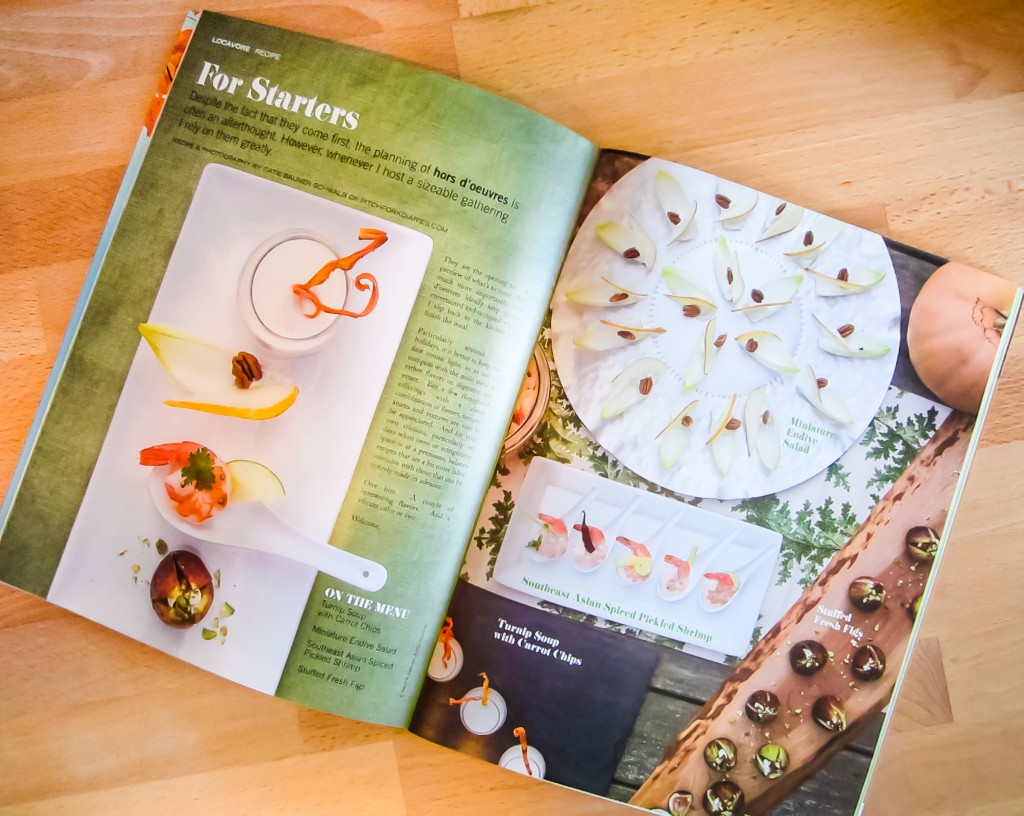 I have a really lovely huge piece in the current issue of the beautiful Green Door Magazine. It is on hors d'oeuvres for Thanksgiving and fall gatherings--including southeast asian pickled shrimp, turnip soup, mini endive salads, and stuffed fresh figs. Issues can be purchased online, in either print or digital, and some of my food piece can be found here. It even has Vincent D'Onofrio on the cover. Happy cooking. | ||||||||||||||||
Here is an elegant meal or appetizer, that takes not more than minutes to whip up. Warm, rich and creamy, it is a great recipe to keep in mind for winter holidays. Serve it with crusty bread for soaking up the outrageously good sauce left behind, or serve the whole thing over pasta for a more substantial dish.
| ||||||||||||||||||||||
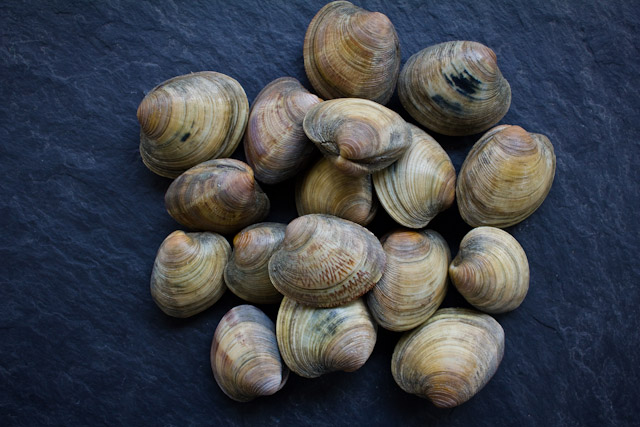 Not just for summer fetes on the beach, clams and other bivalves are a spectacular, and traditional, addition to the holiday table, and perhaps even more importantly, the holiday cocktail hour. A few critical steps can help insure a grit-free mouthful, and will dramatically reduce your chances of getting that one bad clam. Buying Buying the freshest seafood you can get is always the most important place to start, and the best way to help with this is to get to know the people at the seafood counter. If picking them out yourself, look for clams that are not chipped, cracked, or have a damaged shell in anyway. If buying them already bundled, discard any that are broken. Always buy a few more than you need in case of broken shells or clams that don’t open. Storing Store clams in a bowl in the refrigerator covered with a damp cloth. They can keep for a day or two, but the sooner you use them the better for all. Cleaning The day you want to cook them again go through all of the clams and discard any that have a damaged shell. (when in doubt…throw it out.). Scrub the outside of each shell thoroughly to remove any dirt. As you are going through, one by one, if you find a clam that is open, gently tap it on the counter. If it doesn’t close within a minute or two, it is dead and should be thrown out. This is a critical step, as it will look like all the others that have also opened, after they all cook, and yet could potentially make you sick. Any that are dead at the start need to go. Place all of the scrubbed clams in a large bowl, or the sink, and cover with cold water by an inch or two. Allow the clams to sit for twenty minutes in the water. The clams will spit out any grit they have inside their shell. Don’t leave them in the water for much longer than twenty minutes, or they will die. Remove the clams gently, by hand, from the bowl, leaving the dirt and sand behind at the bottom. Pouring them into a colander or scooping them out abruptly could stir up the grit and get it back in the shells. Cook as desired (more on this later this week.). And discard any clams that have not opened during the cooking process.  | ||||||||||||||||
I just discovered the Telepan TV channel on youtube. Bill Telepan is one of my most favorite NYC chefs, who I had the great, great pleasure of cooking with for many months that the start of his inspirational and important Wellness in the Schools school lunch campaign. He has started to put together videos, sharing some of his incredible recipes from his incredible restaurant Telepan. The three recipes using cherry tomatoes in the video above are making me very. very. hungry. Run! and get some cherry tomatoes at the markets this weekend while they are still available (we had a frost at our house last night!). | ||||||||||||||||
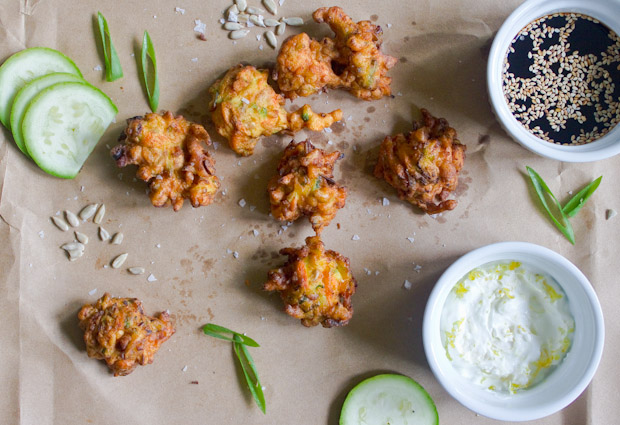 These fritters are an homage to the perfect little hometown restaurant we had in our shoreline Connecticut town growing up in the 80s. A place where everybody knew our name, where you could pop in casually for a wholesome lunch, or count on it for a suitably festive and elegant special occasion dinner. I've been thinking a lot about food of that era lately. As a kid I was permitted to tag along on many grownup restaurant dates, luncheons and dinner parties, giving me the chance to try copious amounts of new foods, many definitely not considered on the childrens' menu. I remember these new tastes and textures more vividly than I do where I was or who I was with (go figure.) But what is most interesting to me in hindsight, is that what was 80s nouvelle cuisine, was in many ways using a huge amount of the same ideas of locavore cooking now--using the freshest possible ingredients, lighter sauces or preparation to let the produce or proteins really be the focus, an overall lighter, fresher, more in-the-moment way of cooking. The only difference being that then it seemed revolutionary and nouvelle, while today it is seen as a return to the basics. This fritter is exactly in keeping with that. The freshest possible ingredients, at the height of their season, minimally dressed up. In the 80s something like this seemed very exotic, today it feels like the perfect, summer, wholesome appetizer, right out of a Deborah Madison book. And plus...ding! ding! ding!...it is something to do with all of those zucchini piling up on your counters, that you perhaps might be starting to resent in just the slightest way.
 | ||||||||||||||||||||||
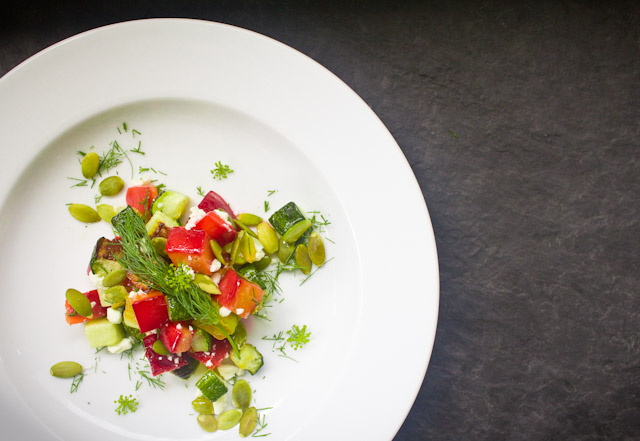 Here is a quick recipe I dreamt up, while on my roasted produce kick this week, using what is in abundance in the gardens and at the market. Thankfully, it turned out to be heavenly, lick-the-bowl-clean good. There is a magical, sum is definitely greater than it's parts, result here, as with many very simple summer dishes (think: Tomatoes+Basil+Olive Oil.). Sweet and sour and earthy and salty and bright and crunchy all going on in your mouth together. Roasting the nectarines and zucchini really intensifies their flavor and makes them both feel like vegetables...or fruit...or something new and unique completely. A beautiful side dish for any summer meal, I imagine this would also be spectacular atop grilled fish, pork, or chicken.
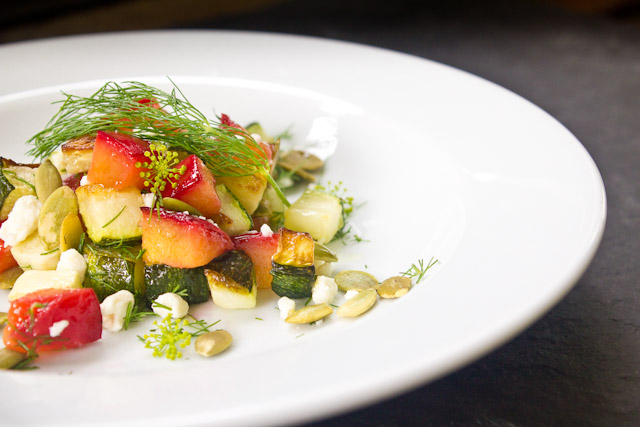 | ||||||||||||||||||||||
 Move over scallions. I may have to cheat on you. My love affair with dim sum scallion pancakes is no secret. There are few times I can think of when they don't appeal to me. (or make me start to go all Pavlovian as I even type the words.) Though green and doing very well, the scallions planted in my garden are still about the size of glorified dental floss and won't be serving up any exotic savories for a few weeks. However, we do have garlic scapes! And herbs! Lots of both! Scallions? Who needs scallions? While not exactly a necessity, (more of an insatiable craving), mother invention shone down and offered up this bright, summery, mildly garlicky, herby, southeast Asian-inspired perfection on a greasy paper towel. There is a tremendous (and tremendously cheap) hole-in-the-wall dumpling shop in NYC's Chinatown, to which I make frequent pilgrimages. Alongside their dumplings, they have a monstrous cast iron pan in which they make a very similar sesame pancake. You can get a pizza-slice-sized wedge "stuffed with veggies" for $1.25, which is split laterally and crammed with shredded carrot and chopped cilantro leaves and stems. There was definitely some inspiration from there in this as well. Give these a try, using all that summer is offering up right now. Shredded zucchini, carrot or beet, torn squash blossoms, thyme, sage, thinly sliced chard could all be welcome additions. Fried dough + farm fresh herbs and produce = What could possibly be bad? (more…) | ||||||||||||||||
Radishes of every color are pushing their way up through the dirt of my garden and attracting paparazzi-esque crowds at the farmers' market. This fresh and this young, they are sweet and mild, and add a peppery snap to salads and summer meals. Try some this week, with this so-easy-my-sheep-could-make-it recipe for irresistible radish, butter, and sea salt crostini. And don't compost the radish greens tops just yet. They are equally edible and equally wonderful. Treat them as you would other hearty bitter greens; sauteed and tossed with pasta, stirred into soups, or whirled into pesto. Here are a few ideas to try out from the kitchn.com. Enjoy! | ||||||||||||||||
With sorrel in its tangy, bright abundance at the farmers' markets now and throughout the summer, this pistou (or pesto or coulis) is a dynamite way to show it off. Set out a platter of baguette slices, ricotta, and the green stuff and let your BBQ guests at it for a DIY appetizer. Less work for you, no soggy for them. Or, as we did last night, set out a platter of it between you and your loved one on the porch and call it dinner. The lemony-green-herbal potency of the pistou is heavenly with the savory-creaminess of the homemade fresh ricotta. But it is also an incredible addition in any place where you want a little herby, slightly sour, punch. Toss it with warm pieces of boiled red potatoes for a new twist on potato salad, stir a small spoonful into a creamy root vegetable soup just before serving, toss with shrimp and orzo for a cold pasta salad, or drizzle over grilled vegetables, seafood, and chicken. This is also a wonderful recipe to use to put away sorrel for the winter. Make a big batch of the pistou and freeze in smaller portions, to stir into heavier winter dishes in the months to come. SORREL PISTOU AND FRESH RICOTTA CROSTINI by Catie Schwalb makes about 1 1/2 cups of sorrel pistou For the Pistou: 3/4 cup, packed, fresh sorrel leaves, thicker stems removed, washed and dried thoroughly 1/4 cup, packed, fresh parsley, washed and dried thoroughly 1 garlic clove 1 cup extra virgin olive oil about 4 turns of fresh black pepper salt to taste, a large pinch at least For the Crostini: Fresh ricotta cheese thin slices of baguette, toasted or grilled if desired For the pistou: Combine sorrel, parsley, garlic clove, olive oil, salt and pepper in a blender or food processor. Blend until uniform and smooth. Taste and adjust salt and pepper to liking. Will keep in an airtight container in the refrigerator for up to a week, but is most green and most flavorful the day it is made. It can also be frozen, and thawed overnight in the refrigerator. Stir before serving. For the crostini: Top slices of baguette, or thinly sliced rustic bread, with a large dollop of ricotta. Top with a generous drizzle of pistou. Serve immediately. Alternative: HERB POTATO SALAD Steam or boil red skinned new potatoes. Cut into bite-sized pieces while still warm, but cool enough to touch. Toss with a generous amount of sorrel coulis. Chill before serving. | ||||||||||||||||
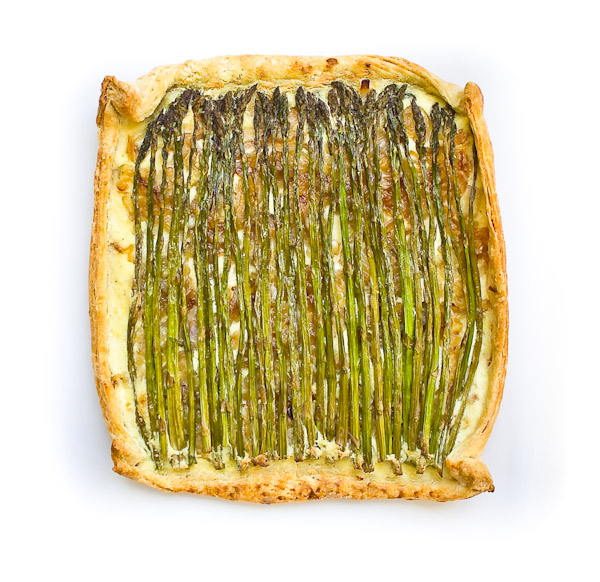 As hinted at earlier this week, asparagus is bustin' out all over on our micro-farm. One of the very first signs of a long season of fresh food from the gardens, this perennial faithfully returns each May, basically without us having to do a thing. (That's my kind of garden vegetable!) Since it is never better than right now, we'll eat just-picked asparagus almost every night for dinner for the next several weeks. Then finally, when we can't stand it anymore, which fortunately is right about when the asparagus season peters out, we'll put our asparagus habit to bed for another 11 months. Once you've had it this fresh and this good, you are spoiled for anything trying to masquerade as asparagus in the rest of the year. But it is a challenge to keep it interesting in the dinners ahead. Even as good as it is, when having asparagus almost nightly, sauteing, grilling, and soup-ing gets old quickly. This savory galette was a very welcomed change, and was gobbled up quickly last evening. It would also be wonderful for brunch, or cut in small squares for late spring hors d'oeuvres. I have been on a galette with corners kick this year, but feel free to form it in the more traditional round shape, or any free-form shape that works for you and your stalks.
| ||||||||||||||||||||||
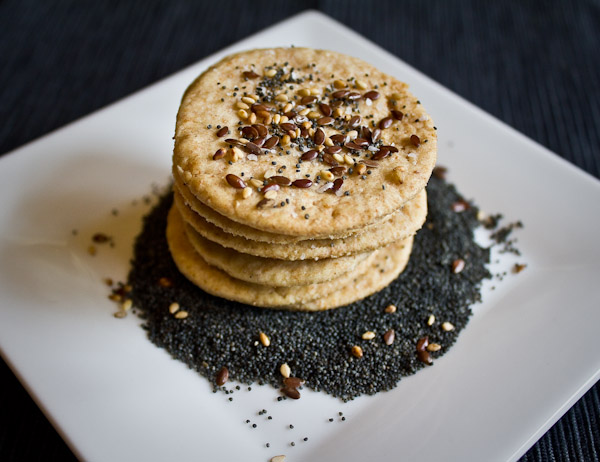 Here is another cracker recipe with which to send you off into the weekend! This recipe and the Cornmeal and Chive Cracker recipe from earlier this week contrast each other nicely, and would make a sublime little cracker basket assortment. This cracker is a little more subtle in flavor and more tender in texture than the other, so pairs nicely with soft, less powerful cheeses too. With or without the everything seed mix and this is a perfect, versatile, go-to cracker recipe to have in your bag of tricks.
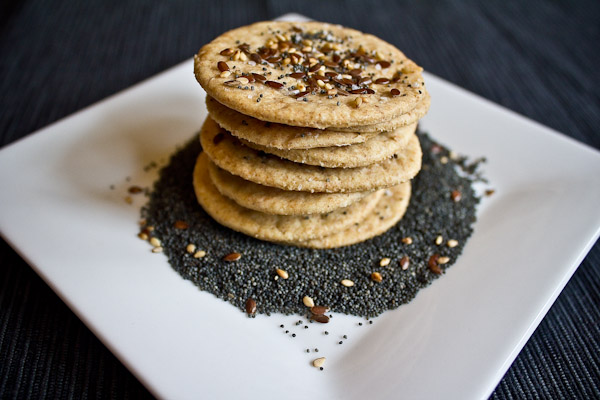 | ||||||||||||||||||||||
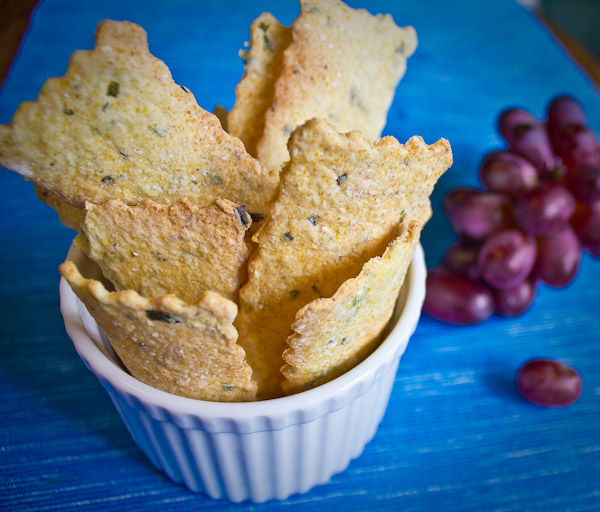 In my ongoing quest to eliminate store-bought processed foods from our kitchen and life, this week I tackled crackers. There is a long and growing list food items that I no longer even think of not making myself, and yet almost weekly I think nothing of tossing (overpriced) box after box of these crisp vices in my shopping basket. Growing up in shoreline Connecticut in the 80's "cheeseandcrackers" were a very big deal. Practically their own extracurricular activity. I vividly remember going to our immpeccable cheese shop on Main Street with my grandmother and picking out an appropriate assortment of contrasting cheeses and suitable cracker sidekicks for that weekend's cheese tray. I was always most intrigued by the layer cake-esque Huntsman cheese, consisting of stripes of Double Gloucester and Stilton cheeses. Carrying on in that early-ingrained tradition, we always have a nice piece or two of cheese on hand and a cupboard stocked with cracker choices for insta-entertaining. So with my long history with cheeseandcrackers, I am even more surprised that making my own crackers hadn't come up before (particularly with now making my own cheese from time to time). A remarkably easy project, offering a gazillion flavor possibilities, from as hearty and rustic to delicate and subtle as you want to make them. When picking out a special piece of carefully crafted cheese, you can decide exactly what vehicle will deliver this creamy treasure to your gullet. Doesn't your own cheeseandcrackers ritual deserve at least as much?
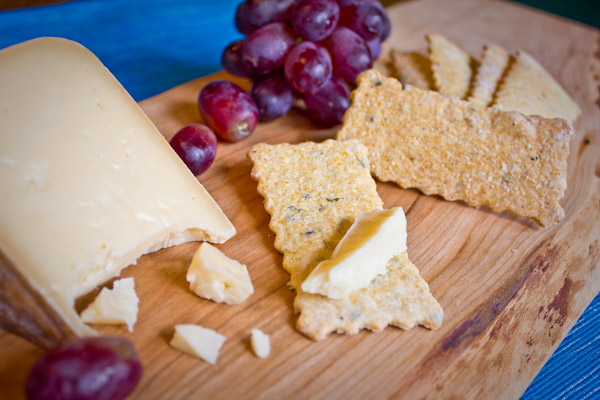 | ||||||||||||||||||||||
Here's a great little dish using those irresistable watermelon radishes and microgreens now growing at a farmers' market near you. Ready in under a half hour, this would be a deceptively easy, super impressive first course for a local-chic dinner soiree. Or triple the scallops, and pair it with cool buckwheat soba noodles dressed with sesame vinaigrette and sprinkled with additional microgreens for a light and springy main course. Either way it uses some of the best items our farmers are offering up at this moment. And after months and months of braised root vegetables, some very welcome fresh leafy crunchy variety.
[caption id="attachment_2004" align="aligncenter" width="600"] 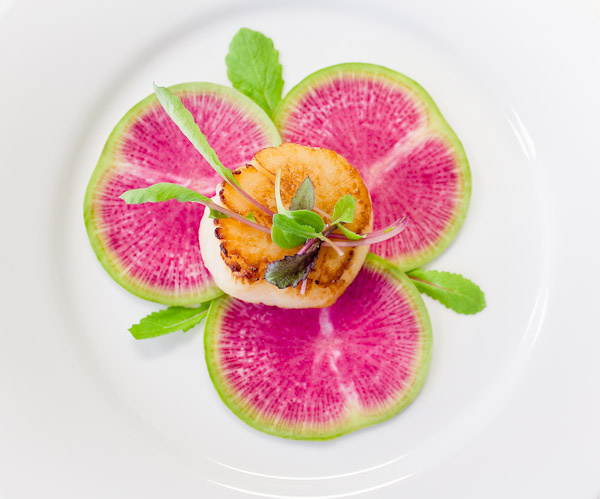 http://www.pitchforkdiaries.com/2011/03/25/pan-seared-sea…crogreen-salad/[/caption] http://www.pitchforkdiaries.com/2011/03/25/pan-seared-sea…crogreen-salad/[/caption] | ||||||||||||||||||||||
Scallion pancakes. Oh how I love thee.
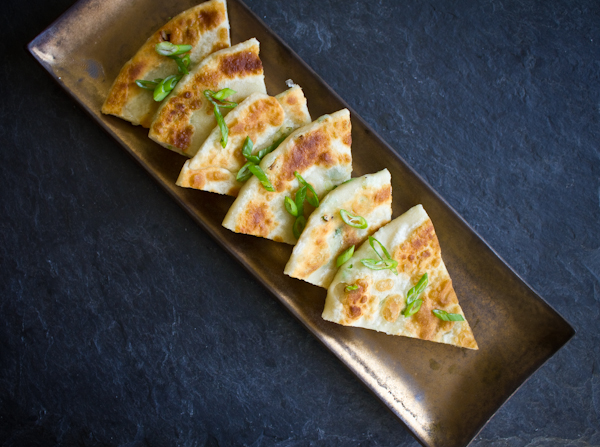 These remarkable, little chewy, salty, scallion-y, layered disks of oily crunchy heaven completely stole my heart when I first had them my first year living in the city a decade and a half ago. Often I would grab a late night snack of scallion pancakes and dumplings on my way home from rehearsal near midnight, back when my metabolism could handle such an indulgence. On our honeymoon in China three years ago, I stumbled upon a mirage-like goddess making scallion pancakes on a narrow back street in Beijing.  Just look at the size of that pan! We got a New York pizza slice-sized wedge (see the table on the right), wrapped loosely in wax paper, that the newlyweds pawed at, stopped dead on the street, like malnourished tiger cubs. Who got the last bite should have gone in a prenup. Too recently I discovered that these treasures are not all that difficult to make yourself--however dangerous it could be to embark upon in the privacy of your own home. Proceed with caution. The management is not responsible for the abandonment of any new year's resolutions. But if only in honor of Chinese New Year, give these a try. The rolled out, uncooked, pancakes can be layered in slightly floured wax paper and stored in the refrigerator wrapped in plastic for about twenty-four hours, and then finished in a frying pan for two minutes on each side. Do we hear a great Year of the Rabbit themed Super Bowl appetizer?
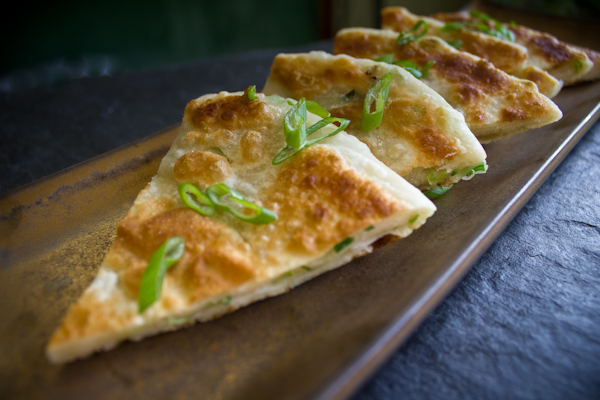 | ||||||||||||||||||||||
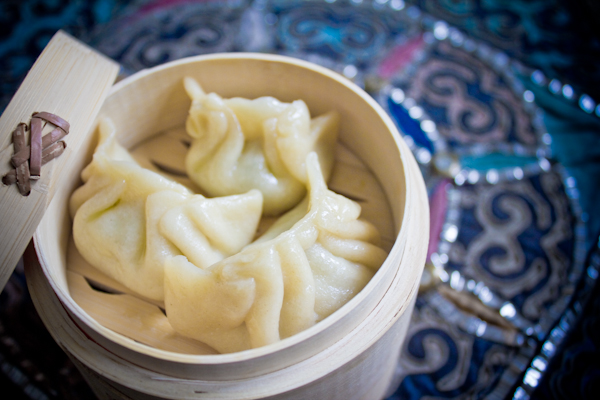 Chinese new year begins tonight at midnight. An integral part of the celebratory feasts are meat and vegetable stuffed dumplings. Called jiao-zi in northern China, they are typically eaten right at the start of the new year. Their crescent shape is reminiscent of the shape of ancient Chinese currency, silver and gold ingots, and eating them at the birth of the new year is thought to bring wealth and prosperity. When I first moved to New York City in the mid-nineties, I had my first taste of really authentic chinese dumplings. It was love at first slightly-burned-tongue. More of an obsession, to be honest, as I would devour as many as I could afford, as often as I could justify. Three years ago, my husband and I celebrated our honeymoon in China. I had the wonderful good fortune of being able to learn a tremendous amount about the cuisine, with trips to many local markets, tremendous meals, and some cooking lessons at the Cloud 9 cooking school in Yangshuo on the banks of the breathtaking Li River. One of the dishes we cooked in class were dumplings. Here is one of our lovely teachers explaining how to fold the rounds of dough into the crescent shape. http://www.youtube.com/watch?v=aphirz7wcbM So below are my recipes for both pork and vegetable dumplings. I have adapted them through the years from what I learned in that class, what I've learned from a big assortment of great cookbooks, and most definitely from what I've learned from eating this favorite of any food I can think of. On a desert island, these are what are coming with me. I am sure there are Chinese grandmothers who will find unauthentic hues in some part of my recipes. But they are as authentic as I've been able to learn through every best effort, and when I burn my tongue with that first divine chewy bite, send me back to China and Chinatowns I've loved, and make me feel very fortunate.
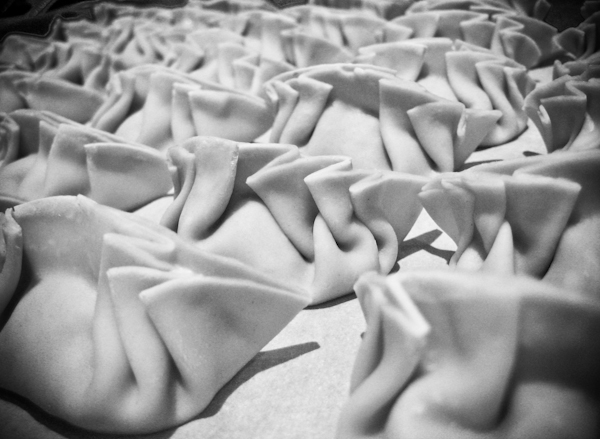 | ||||||||||||||||||||||
In honor of last week's National Popcorn Day, I've done some tinkering in the kitchen with flavorings. My favorite project was coming up with different flavored salts. It is outrageous that I haven't done this sooner, and even more outrageous the number of super costly little precious jars of flavored finishing salts that I have sitting in my spice cabinet. The technique is nothing more than combining good quality salt, either kosher or sea salt, and good quality spices, herbs, citrus, or a combination. It is up to you as far as the ratio of salt to flavors, depending on how concentrated you want the flavor and the color, and how strong the ingredient is you are using. On average I used about 1 part flavor to 1 1/2 parts salt. Simply put all ingredients in a spice grinder, coffee grinder, food processor, or mortar and pestle and pulse or grind until well incorporated. Hint: For spices, toast them lightly first to release more of their flavor. Place them in a dry pan over medium heat, swirling frequently for a few minutes until they start to become fragrant. This powdery little flavor bomb is amazing sprinkled over hot fresh popcorn, and as a finish for so many of your dishes. It also looks gorgeous as a pop of color sprinkled around a plate. They'll keep for about a year in an airtight container, making them fantastic gifts. I mean, have you seen what these things cost lately? Here are a few ideas below, but the combinations are endless. Keep a little jar or two on your counter, and you'll find yourself using them on everything. Put a few small dishes on your dinner party table, and let guests play with their food. CURRY SALT I used a brilliant french version of an indian masala, called Vadouvan, from the exquisite Spice House in Chicago. Amazing on popcorn, but also chicken, fish, roasted vegetables (especially cauliflower), or a cold chicken salad. PIMENTON SALT Smokey, sweet, brilliantly colored spanish paprika. It rocked on popcorn. Would also be stunning on fried eggs, roasted potatoes, grilled shrimp, and roasted meats. CHIVE AND SHALLOT SALT I used some high quality freeze dried shallots and chives (again, thank you Spice House), resulting in a savory blend that exploded with the most amazing aroma as it hit the hot popcorn. It was also absurdly good on my poached eggs this morning, and the small batch is almost gone. Mashed potatoes? Yes. Roast Chicken? Yes. Just about anything you want to spruce up with a little savory brightness? Most definitely. Bonus points for drying your own homegrown chives. CITRUS SALT Zest the peel of a lemon, lime, orange, meyer lemon or tangerine. Allow to dry on paper towel, and then combine with salt. Poultry and seafood would be particularly good, as well as roasted peppers. VANILLA SALT Split and scrape a vanilla bean, and combine seeds with salt. Could have interesting results with some delicate fish and lobster, but I'm dreaming more of a stunning salty finish to a dessert, on a scoop of dense gelato, or a crunch on dark chocolate covered caramels. CHINESE FIVE SPICE POWDER SALT Get the best five spice you can, and then bring me the popcorn! ...And the roasted chicken wings, roasted pork, roasted brussels sprouts, and noodles. PORCINI SALT Pulse dried porcini mushrooms in grinder to a fine powder, and then pulse with salt. This earthy, chocolaty, elegant finisher adds a new element to a side of rice, a creamy pasta, eggs, a crostini with oozy cheese, or topping a puree of potato soup. LEMONGRASS AND KAFFIR LIME Dry both slightly, and grind with salt to make a bright, southeast Asian inspired topping. Beautiful in a ramen soup, on grilled fish or chicken, and even as an unexpected finisher to desserts. 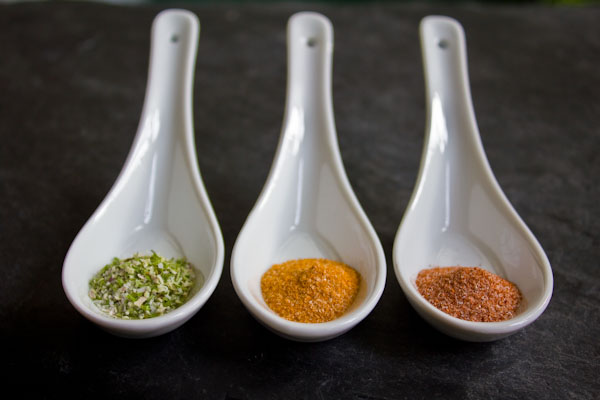 | ||||||||||||||||
[caption id="attachment_1177" align="alignleft" width="319" caption="My younger sister, circa 1996."]
 [/caption] [/caption]This Wednesday was National Popcorn Day. Yes, I seemed to miss the parade too. We ate gallons of air popped popcorn growing up. And later in the 80s, I quite willingly made the transition to the ballooning bags in the microwave. Then on August 14, 2003 my popcorn life was changed forever. That day was the massive blackout across most of the northeast. I was living in Brooklyn at the time, and working in Times Square. With every form of public, and private, transportation debilitated, I walked to a friends apartment (in flip flops) thirty blocks south. I spent the night there, before walking across the Brooklyn Bridge (ah-hem, flip flops) the next morning. With no electricity, we scrounged up a pretty great eight-hour happy hour in their courtyard, subsisting mostly on popcorn popped on their gas stove. If you haven't made it before, RUN (ideally not in flip flops) to your stove and whip up a batch of anti-microwave popcorn. The instructions are below. A bag of kernels yeilds so much more, costing so much less, than a box of three microwave bags. And you get to control the flavor, fat, salt, and freshness of the whole production. (psssst...a lot less packaging and waste for the planet too!) Look for popcorn kernels at your farmer's markets as well! A great, whole food, snack that you can easily replenish again and again on game day. And coming up next is the main attraction: DIY Flavored Salts!
| ||||||||||||||||||||||
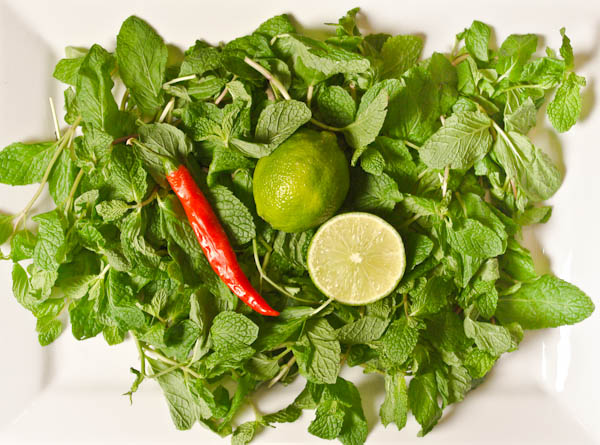 First, I would love to have mouthwatering photos of fresh, succulent oysters, glistening under the spell of my dipping sauce. But alas, the shucking big snow storm this week kept my delivery from getting from the Chelsea Market to me in middleofnowhereville, and my dinner guests from being my oyster sauce guinea pigs. So you'll have to take my word for it, that it both tastes and looks spectacular. Thai food typically has a balance of four flavors: salty, sweet, sour, and spicy. This sauce is no exception, with sour lime, salty fish sauce, spicy thai bird chili (frozen from this year's garden), and a little sugar to balance it all out. I am a purest when it comes to slurping down those bivalve blobs of heaven, often eating them plain, or with just the slightest drizzle of a classic mignonette sauce, but there is something about this sour-herbal-savoriness that thrills me. It will also look like confetti in a bowl for your new years fete. Oh, and with all of the extra herbs and limes you have, try out a mint & thai basil mojito. 10...9...8...7...6....
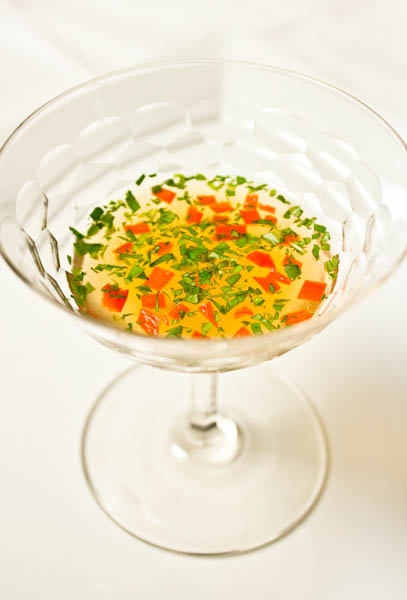 | ||||||||||||||||||||||
 This remarkably simple, and remarkably comforting recipe has always been a part of our holiday meals. When she first started making it, my grandmother used to enjoy quizzing unsuspecting guests as to what the star ingredient was in the soup. It is so mellow, and balanced, and not cluttered with leek or potato, that it is actually hard to discern that it is simply the lowly turnip. As a kid we would slurp down bowl after bowl of this creamy winter favorite. It was always present at cold weather dinner parties thrown by my parents, as surprisingly, it was a safe bet to please a large crowd. Again, not attributes, if I think about it now, I would consider assigning to this particular vegetable. But try this one! It is wonderful, and makes me joyfully lug home heavy bags of turnips (white or purple) as soon as they arrive at the farm stands. It is a warm and soulful start to most of our Thanksgiving meals together.
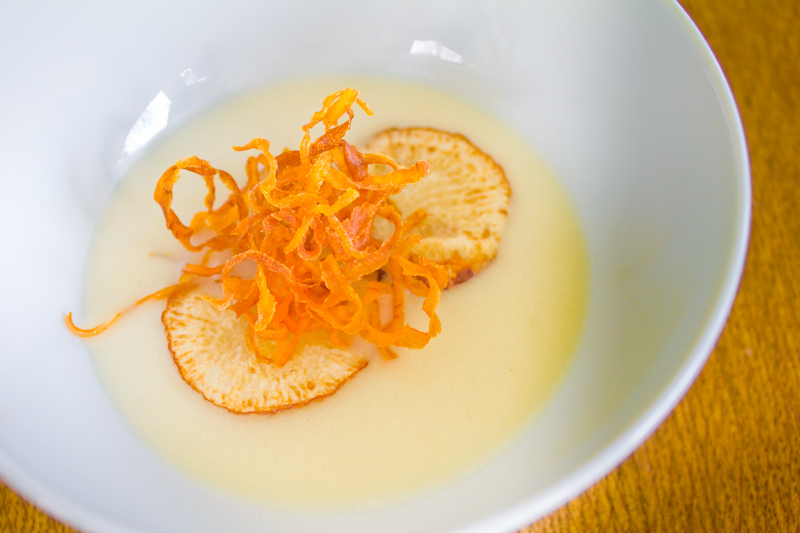 | ||||||||||||||||||||||
 First, yes, it is a terrible pun. But in all honesty, I had a dream about writing this post, and that is the title I watched myself type in the dream. So who am I to interfere with subconscious inspiration/intervention? Moving on... Our garden is still loaded with beautiful food. But as is the case when September shows up, the plants are not looking quite as robust as they did a few weeks ago. There is definitely a sign that it is the end of the season and these plants are tired. However, our gorgeous Five Color Silverbeet Chard, that was looking a little peaked in the hottest days of August, has started to really perk up in this last week, with it's cool evenings. I first started growing this heirloom variety of chard, after reading Barbara Kingsolver's glowing endorsement of it in Animal, Vegetable, Miracle: A Year of Food Life "If I could only save one of my seed packets from the deluge, the heirloom vegetable I’d probably grab is five-color silverbeet. It is not silver (silverbeet is Australian for Swiss chard), but has broad stems and leaf ribs vividly colored red, yellow, orange, white or pink. Each plant has one stem color, but all five colors persist in a balanced mix in this beloved variety. It was the first seed variety I learned to save, and if in my dotage I end up in an old-folks’ home where they let me grow one vegetable in the yard, it will be this one." Chard is a wonderful culinary green, loaded with iron and antioxidants. It stands up well in soups, and sautés, as well tarts and fillings. It is a great alternative to spinach and kale, and unlike either, comes up early in the garden season and lasts through early frosts. With it too warm to have spinach in the garden lately, I substituted chard recently in Spanakopita-inspired phyllo purses. These little bundles are impressive and loaded with summer flavor. The filling is also equally good folded into larger phyllo pockets for a great lunch or vegetable dish. 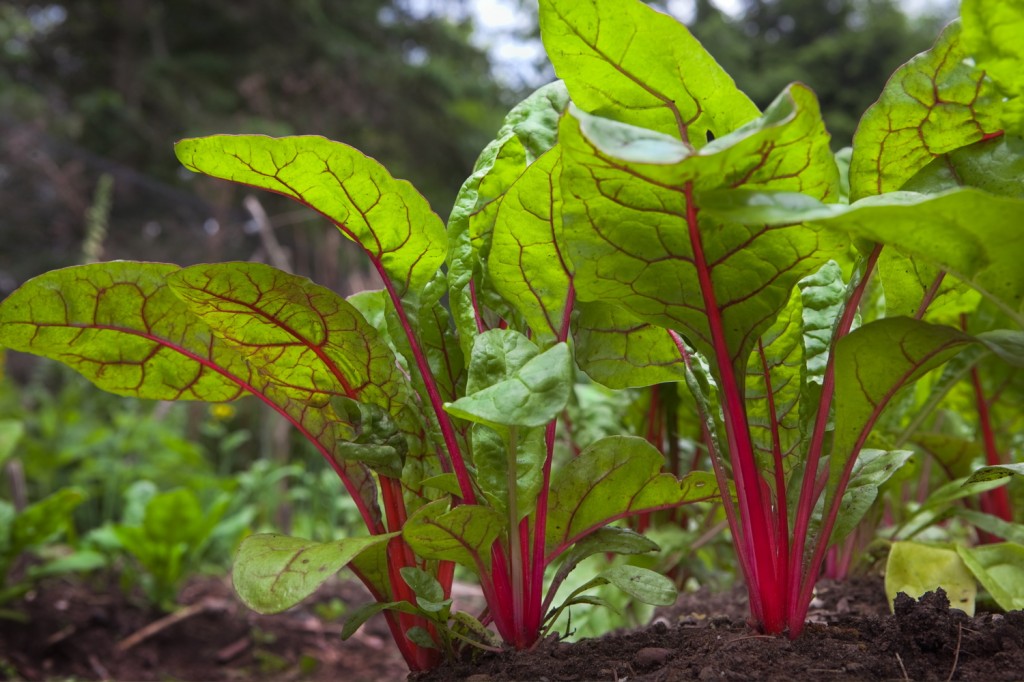 CHARD, DILL, AND FETA BUNDLES by Catie makes approximately 30 hors d'oeuvres bundles, or 10 large pockets. 2 TBS Olive Oil 1 small Sweet Onion, diced small Large bunch of Chard, about 1 lb, tough stems removed and roughly chopped 1 TBS fresh Dill, chopped, or 1 tsp dried Dill 2 TBS fresh Parsley, chopped 4 oz Feta Cheese, finely crumbled 1 egg, slightly beaten Salt and Pepper, to taste 1/2 pkg of Phyllo Dough (8 oz) melted butter Heat the oven to 350° F. Heat the oil in a large pan. Add the diced onion and gently saute until fragrant and translucent. Add the chopped chard, in large handfuls, as it starts to wilt down. Saute for a minute more until just cooked, adding the dill and parsley about 30 seconds before removing from heat. Using either a spoon on the edge of the pan, or pouring the mixture into cheesecloth, squeeze out and drain as much liquid as you can from the vegetables. Add the feta cheese to the chard mixture and evenly combine. Taste the mixture at this point before seasoning. Feta is salty and you may only need to add pepper. Once you are happy with the seasoning, add the egg and mix well. Unwrap the phyllo dough, and keep flat under a damp towel or paper towels. On a counter or cutting board, place one sheet of dough. Brush dough lightly, but evenly, with melted butter, and top with another sheet of dough. Repeat so you have a stack that is three sheets thick. With a large knife or pizza cutter, cut sheets into 6 pieces (down the middle the long way, and then in thirds in the other direction). Place about a tablespoon of chard mixture in the center of one of the phyllo rectangles, gather up corners, and twist slightly in one direction. Place on a cookie sheet. Repeat with remaining mixture and dough sheets. 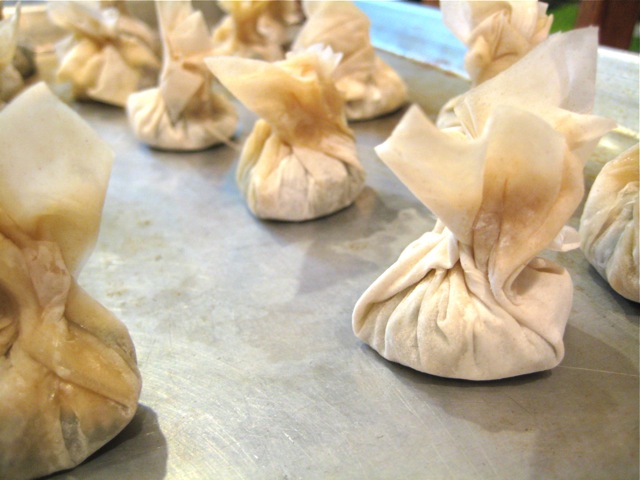 Alternatively, you can cut the stack of three sheets in half, lenghwise, put about 1/3 of a cup of mixture in the lower right corner, and then fold in triangles, as you would fold a flag. Bake for 15-20 minutes, until dough is golden brown. Bakelightly longer for the larger triangles.  | ||||||||||||||||
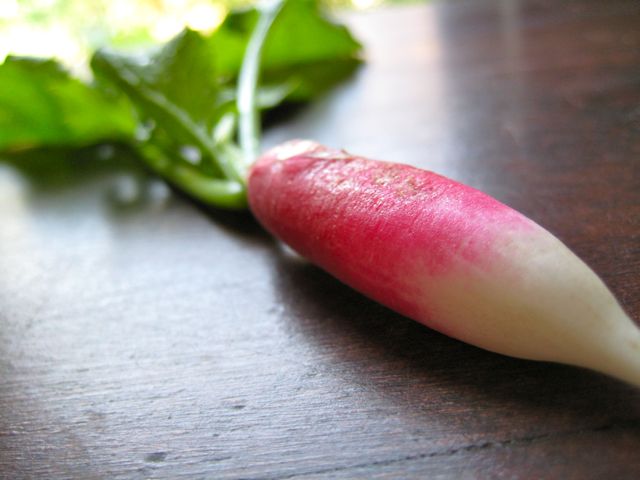 This, all too brief, time of year when the garden is offering up treasures I would drive multiple time zones for in February, I find myself stumped in the kitchen. Surprising, since I have before me the best raw materials I will see all year. But that’s just the point. I want to step aside, get out of their way, and let these vibrant little bundles do what they do best all on their own. How can I possibly improve upon late summer perfection? This year for the first time we are growing in our gardens elegant little french breakfast radishes and delicate and creamy fingerling potatoes. The radishes have been surprisingly successful and grow quite rapidly. As a kid radishes were one of only two foods I wouldn’t touch (the other was PB&J….) But these are crisp and bright, and have a wonderfully mild peppery zing. The potatoes have just started to bear fruit, almost a foot underground. I have been diligently nursing the plants all season, mounding and mounding the dirt. When I read on the internet the other day that the first small new potatoes should be ready around day 60, I was sent into a complete impromptu digging frenzy. No plan, no shovel, and dirt painfully jammed very deeply under my triumphant fingernails. But so very worth it for the small two serving colander-full that I brought in for supper. They were a revelation. Fragile, tissue-paper thin skins, and a complex flavor that reminded me that these were a delicacy, not just a background starch. Here are two quick and simple recipes that showcase these vegetables in their purest form, with nothing covering up their brilliant flavors. If you can get beauties from the farmer’s market, or your garden, it is like tasting potatoes and radishes for the first time. French Radish Crostini (first taught to me by Jacques Pepin) Fresh Radishes Butter, higher quality the better, room temperature Sea Salt Crusty Baguette Slice radishes as thinly as possible. Thinly slice the baguette, slightly on a bias, in 1/4-1/2” slices. Spread liberally with butter. Layer radish slices on buttered bread. Sprinkle with sea salt. (Note: Baguette slices may be toasted slightly on a cookie sheet if desired.) Oven Roasted Fingerling Potatoes New Fingerling Potatoes Olive Oil Thyme Sprigs, stems removed Salt and Pepper Heat oven to 400 °F. Cut potatoes, if necessary, so that they are fairly uniform in size, but try to keep as many whole as possible. Toss with enough olive oil to evenly cover. Add thyme leaves, a few large pinches of salt and grinds of black pepper. Toss again to evenly distribute. Pour into a roasting pan or baking sheet, preferably in a single layer. Roast in the oven until tender, about 40 minutes, depending on the size of the pieces. 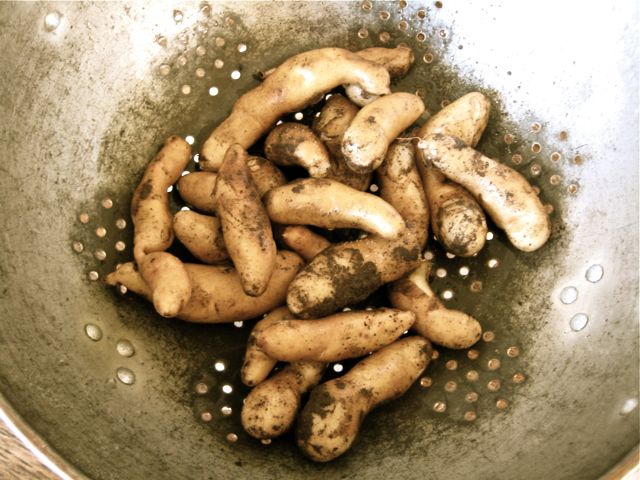 | ||||||||||||||||
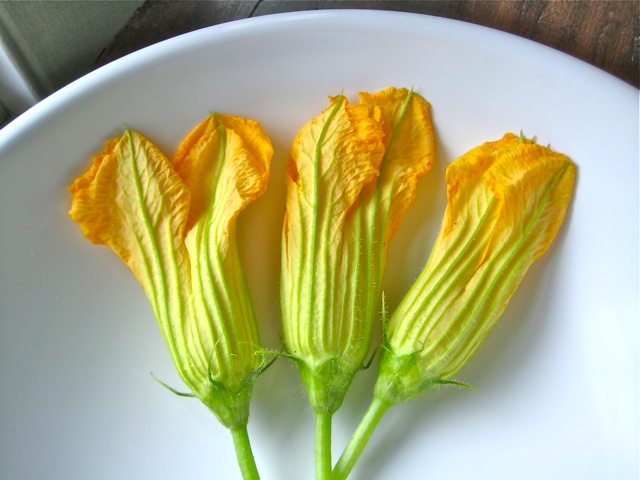 Our few small winter squash plants, that I started from seed this year, have taken off, and taken over, and are now literally climbing the walls of the new squash garden we put in. It is still amazing to me that one tiny 1.5 cm long seed can turn into a gigantic sprawling little-shop-of-horrors-like vine with leaves that are waist-high. Looks like we will pretty certainly have an abundance of squash, and currently have an abundance of glorious, delicate, and elegant squash blossoms. If picking them yourself, try to do it early in the day, when they are open and slightly more resilliant--they tear very easily. Also, you'll want to pick the male flowers, as the females are the ones that the squash will grow from. So with our glut of blossoms, guess I'll just have to stuff them with creamy cheese and fry them, fry them, fry them. 
 | ||||||||||||||||||||||
Ummmm...eggs...ramps...potato...
 When my brother returned from his junior year in Spain, he craved the egg tortilla espanola found on the counter at most tapas bars and eateries. It also happened to be one of my favorite recipes I learned in my "egg" lesson in my first weeks in culinary school (thank you Chef Justin). The farmer who I get my ramps from, Rick Bishop, has mentioned to me a few times how much he likes to cook ramps and eggs together. With a good amount of my own foraged ramps still left, this turned out to be a great combination.
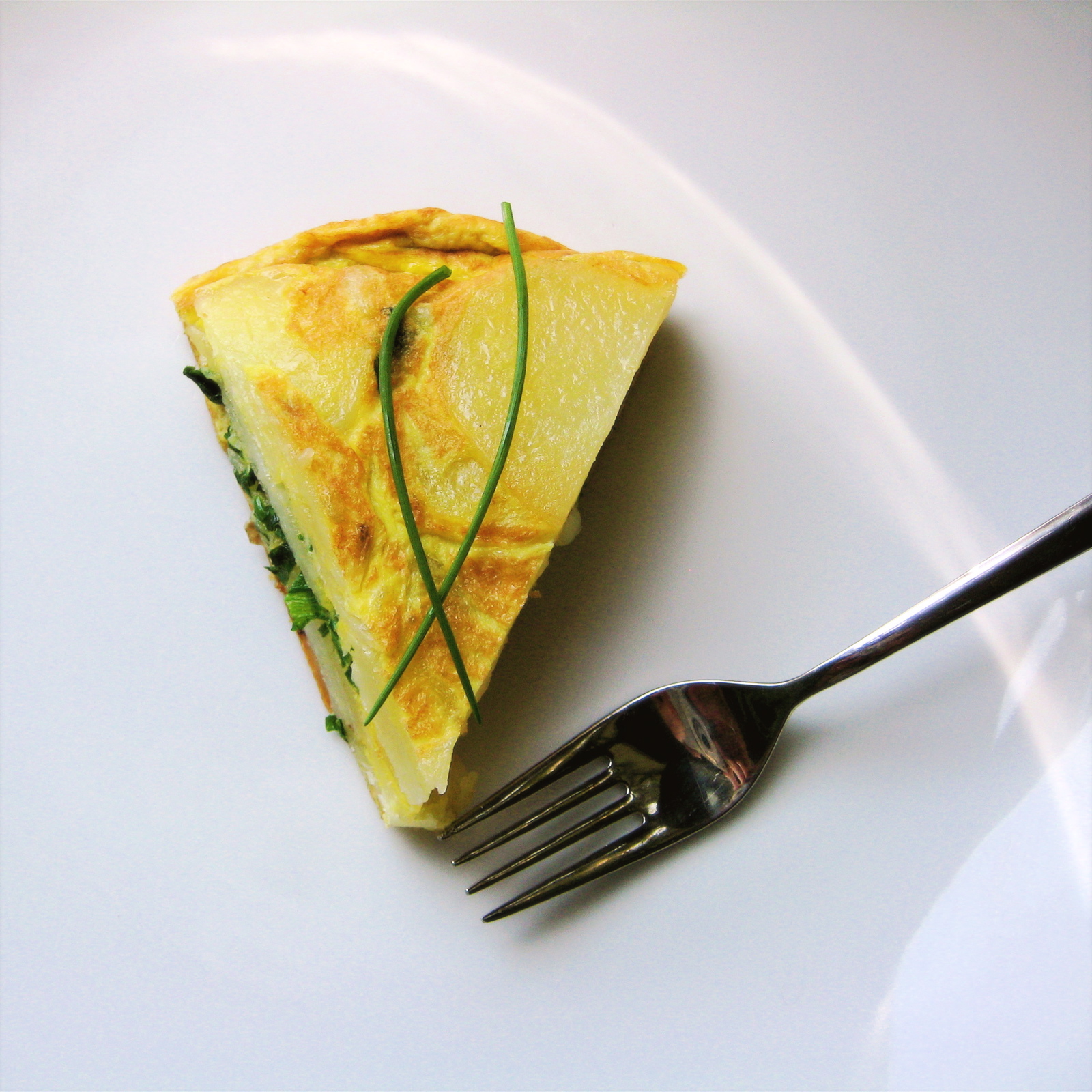 | ||||||||||||||||||||||
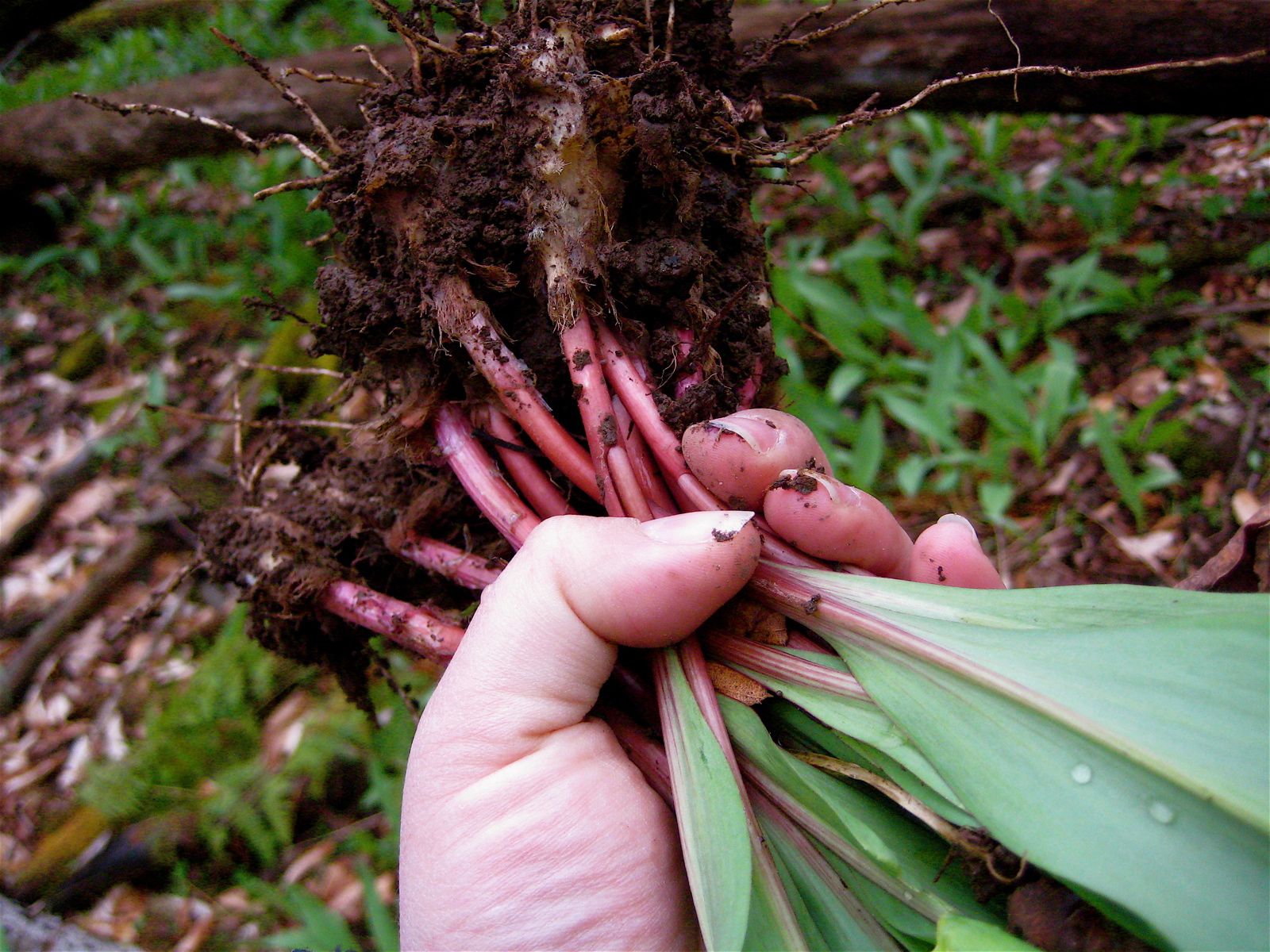 This past weekend friends who live near us upstate, on an area overrun with ramps, graciously invited us over for our second annual swap of all-we-can-pick ramps for a pick-up truck full of our "like gold" sheep manure for their garden. (So very cutting-edge-hipster-locavore. Then again, poop for weeds...) After a very muddy morning, we brought home two substantial garbage bags of ramps with their roots and soil intact, to transplant to our woods, and a very generous shopping bag of loose ramps to cook and eat. I got to work on a big batch of these slightly hot, slightly sweet, bright and tangy pickled ramps that night. I am now addicted, and looking forward to ice cold pickled ramp martinis later this summer. Oh, and picked ramps also go brilliantly with fish and roasted meats, on sandwiches, or alongside cheeses and charcuterie.
 | ||||||||||||||||||||||
On a trip to the farmers market it doesn't serve you to bring a list or to have rigid expectations. The most effective shopping there is always done by just discovering what is the very best of this week's offerings. As mentioned before, that can sometime be rough in the less produce-friendly times of year.
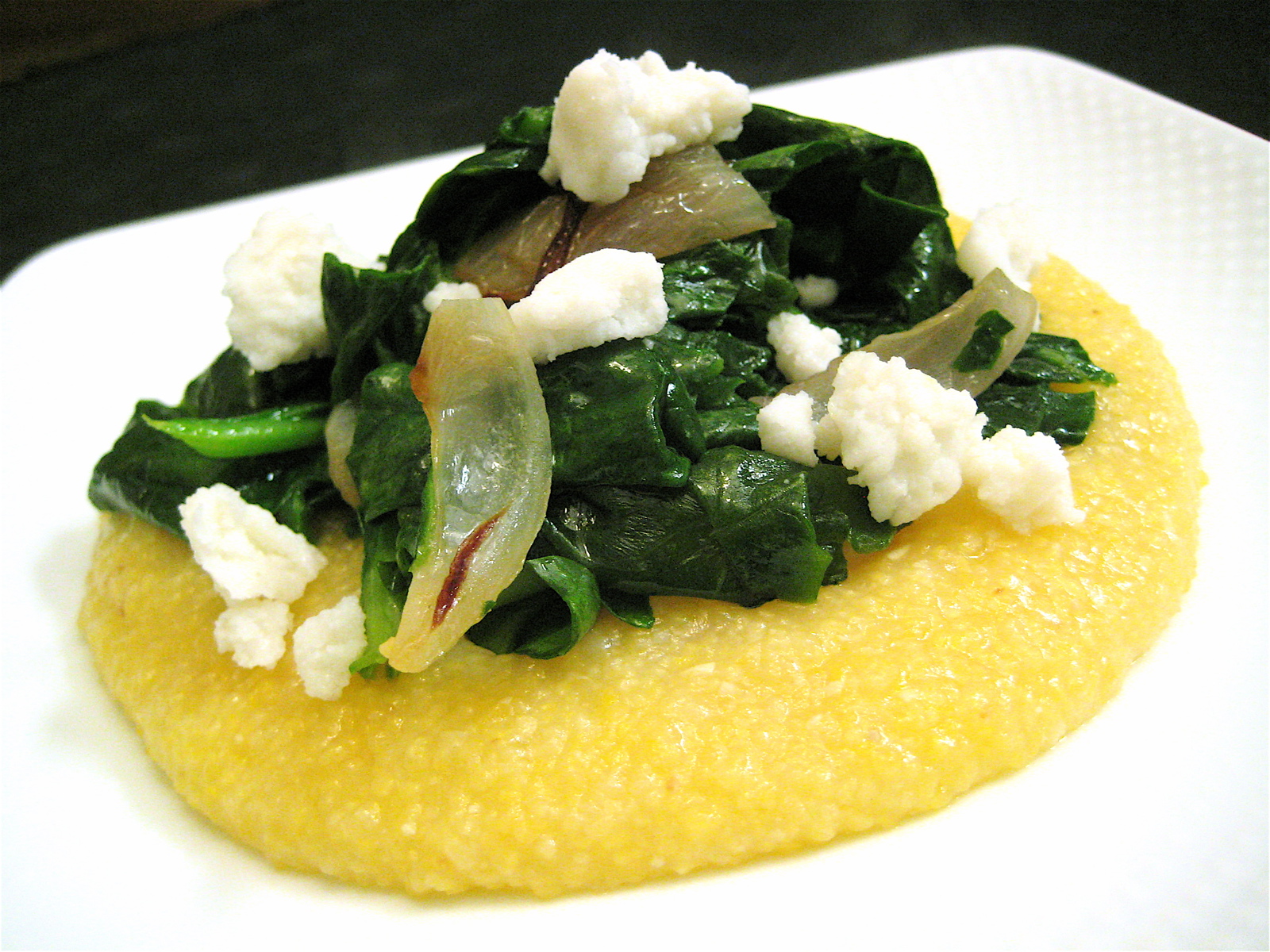 This week the stars, or farmers, seemed to align. There are a few bonuses of spring starting to show up, and enough cold storage winter vegetables left to anchor a recipe. I found sweet, plump shallots, an abundance of hearty greens, luscious queso blanc made from goats milk, and had a few bags of organic polenta from a farm in Ithaca, NY, I had stocked up on during a previous market day. They all came together beautifully in this comforting, yet bright dish. A great vegetarian meal, or elegant side dish, that could be easily expanded to a more substantial meal by adding some braised chicken thighs or aromatic local sausages to the mix on top.   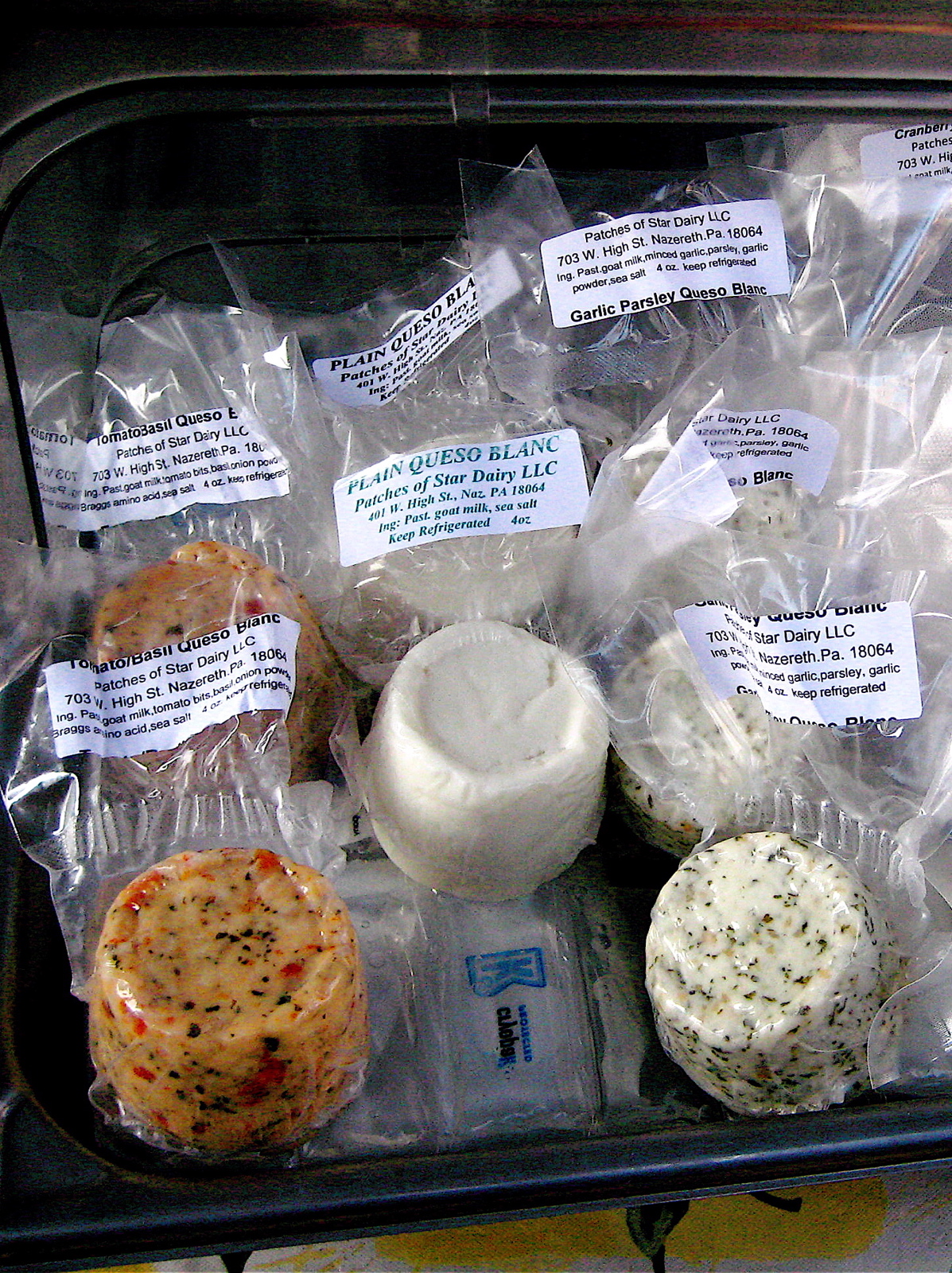 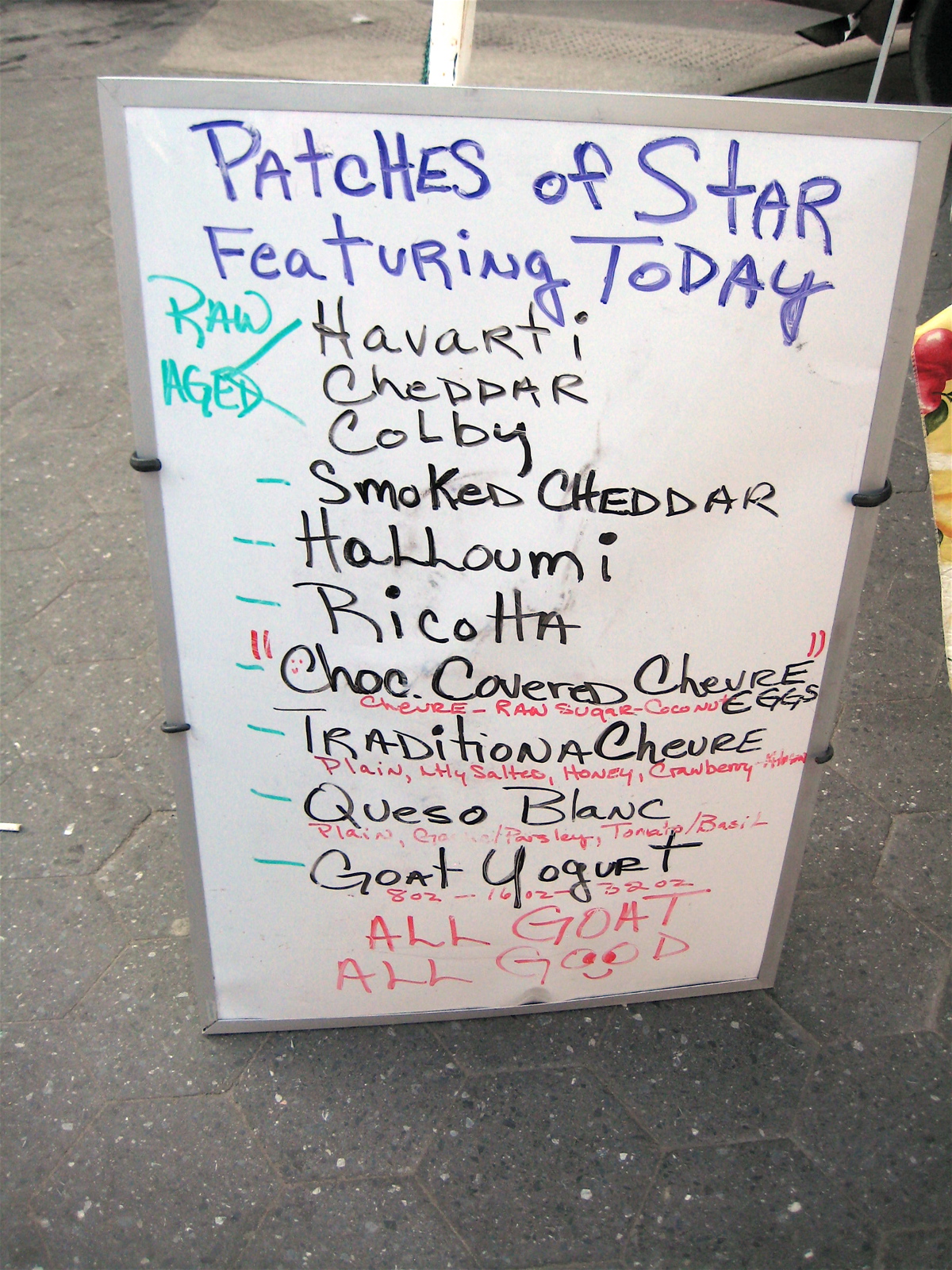
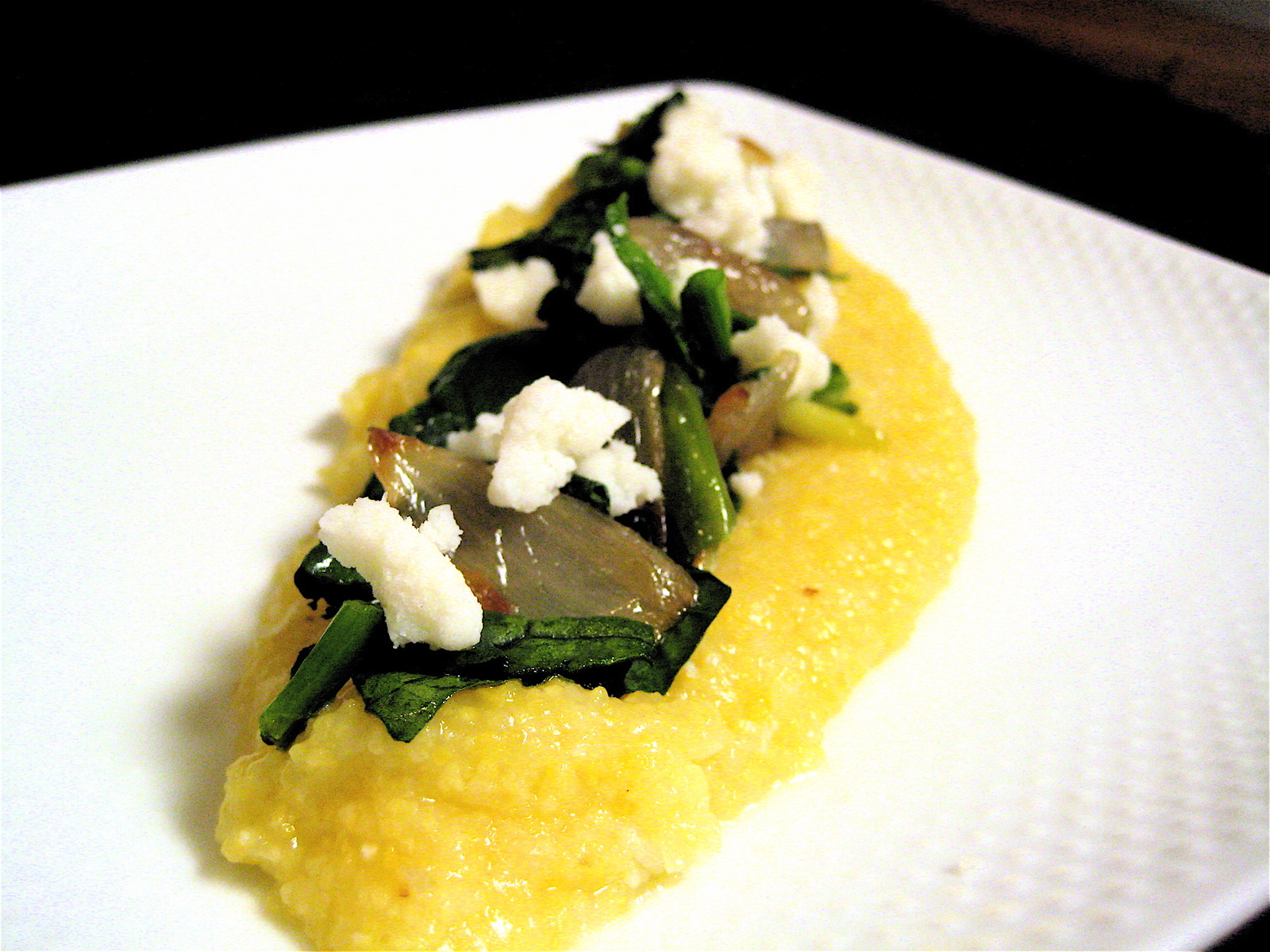 | ||||||||||||||||||||||
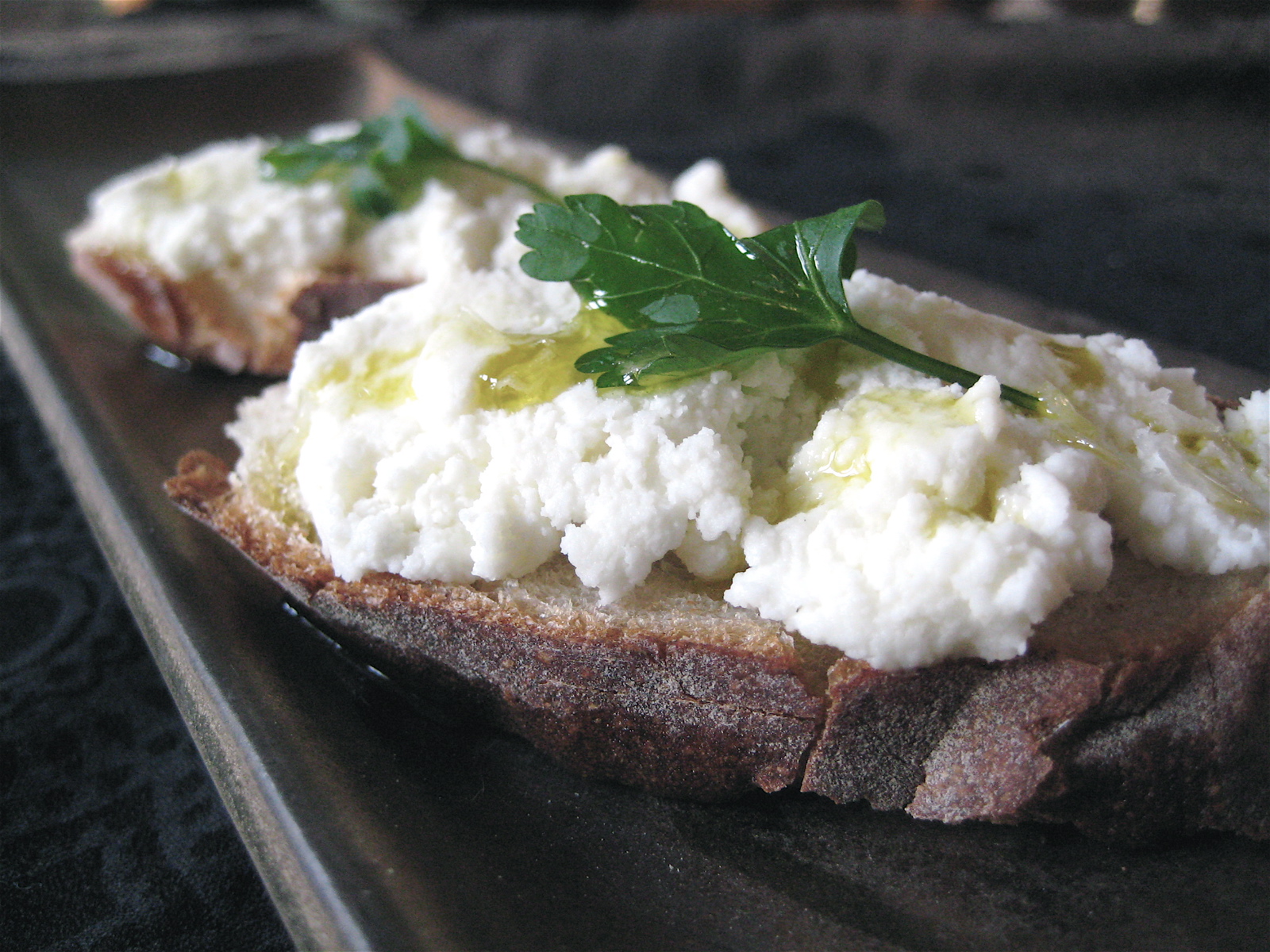 Lately we have been getting the most wonderful fresh milk from Dirie's Farm, a small family-owned dairy farm near us. The milk has a whole melody of flavor, that clearly illustrates what people are talking about when they refer to the terroir in wine. You can taste this area. You can taste the differences in the seasons, and the grassy fields and hay on which these cows are feeding. A few months ago I had an impromptu lunch out by myself (I mean, with my date, New York Magazine) at Veloce Pizzeria in the East Village of NYC. They have a divine ricotta crostini "spuntini" (Italian snacks). Superb rich ricotta slathered on crusty toasted bread with fresh black pepper. Heaven. So craving that, this week's farm milk became glorious ricotta. It's easy, easy, easy. There are many recipes out there, using several different acidifying agents (vinegar, lemon juice, buttermilk, and citric acid). I learned this from my culinary school, and Ricki the Cheese Queen, both using the exact same method with citric acid, so I'll stick with that. Citric Acid is pretty widely available. It is often called for in canning tomatoes. I have seen it in my grocery store near canning supplies or products like Fruit Fresh. But you can also easily get it here, from the wonderful New England Cheesemaking Supply Company.
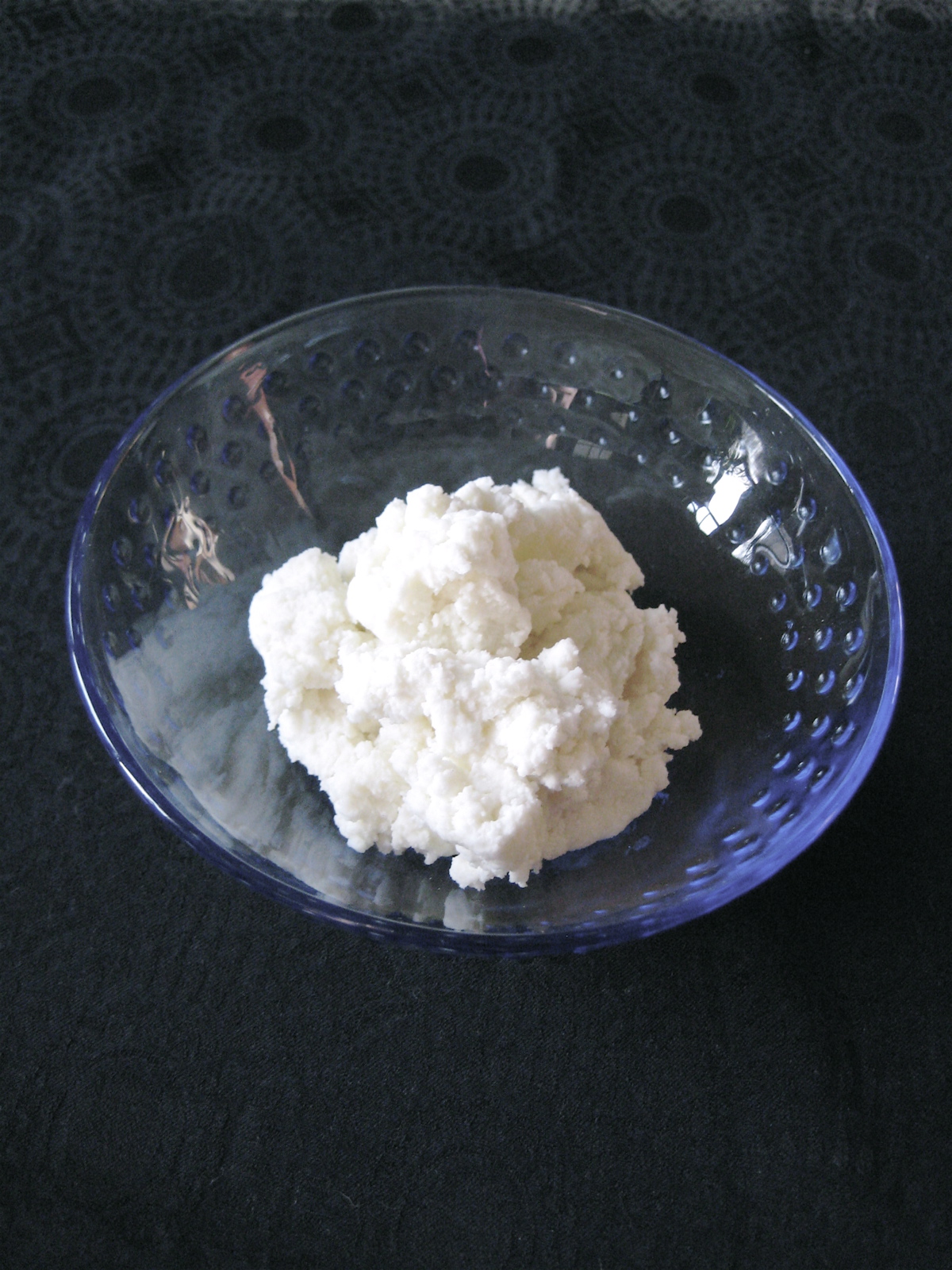 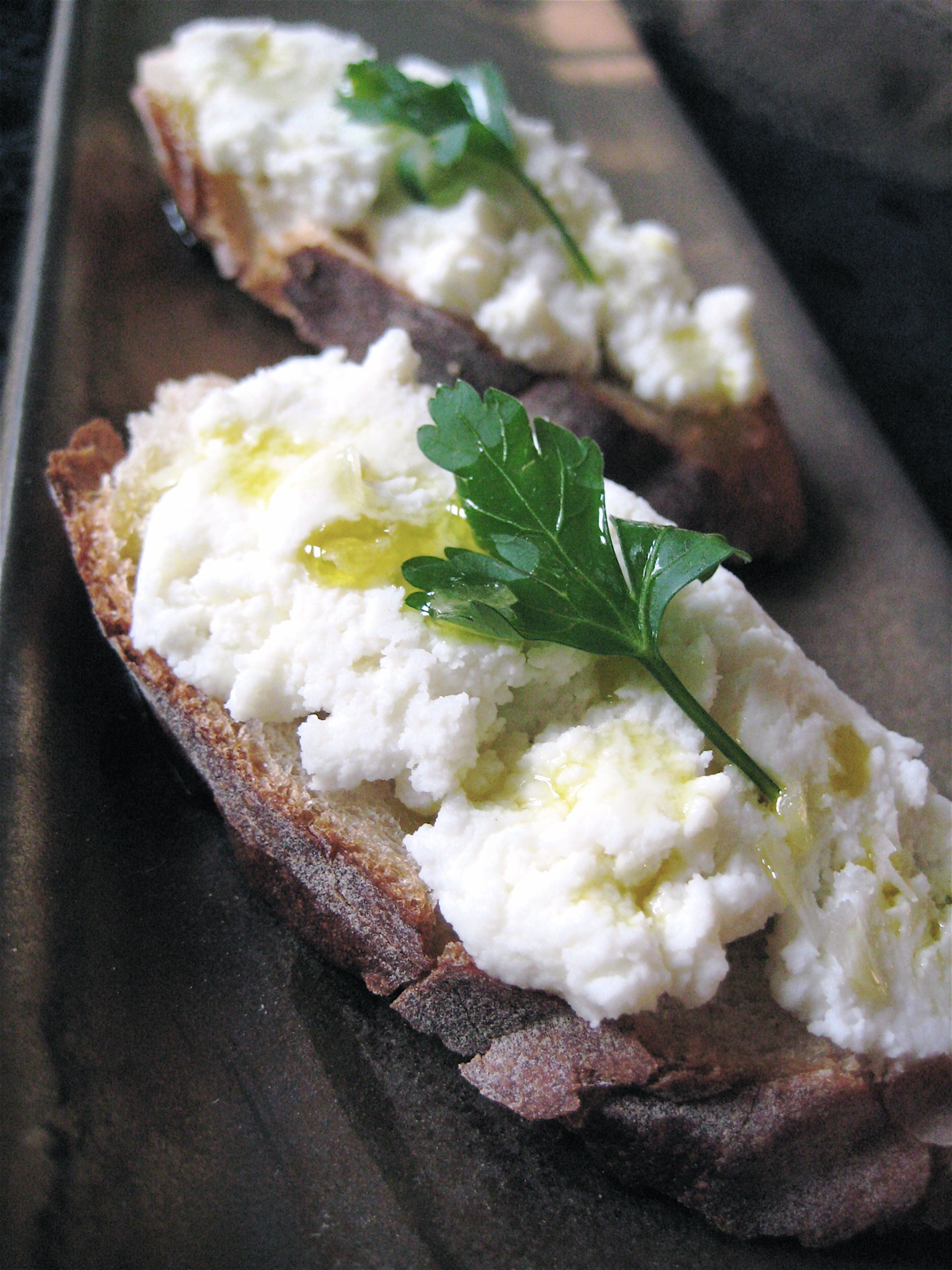 | ||||||||||||||||||||||
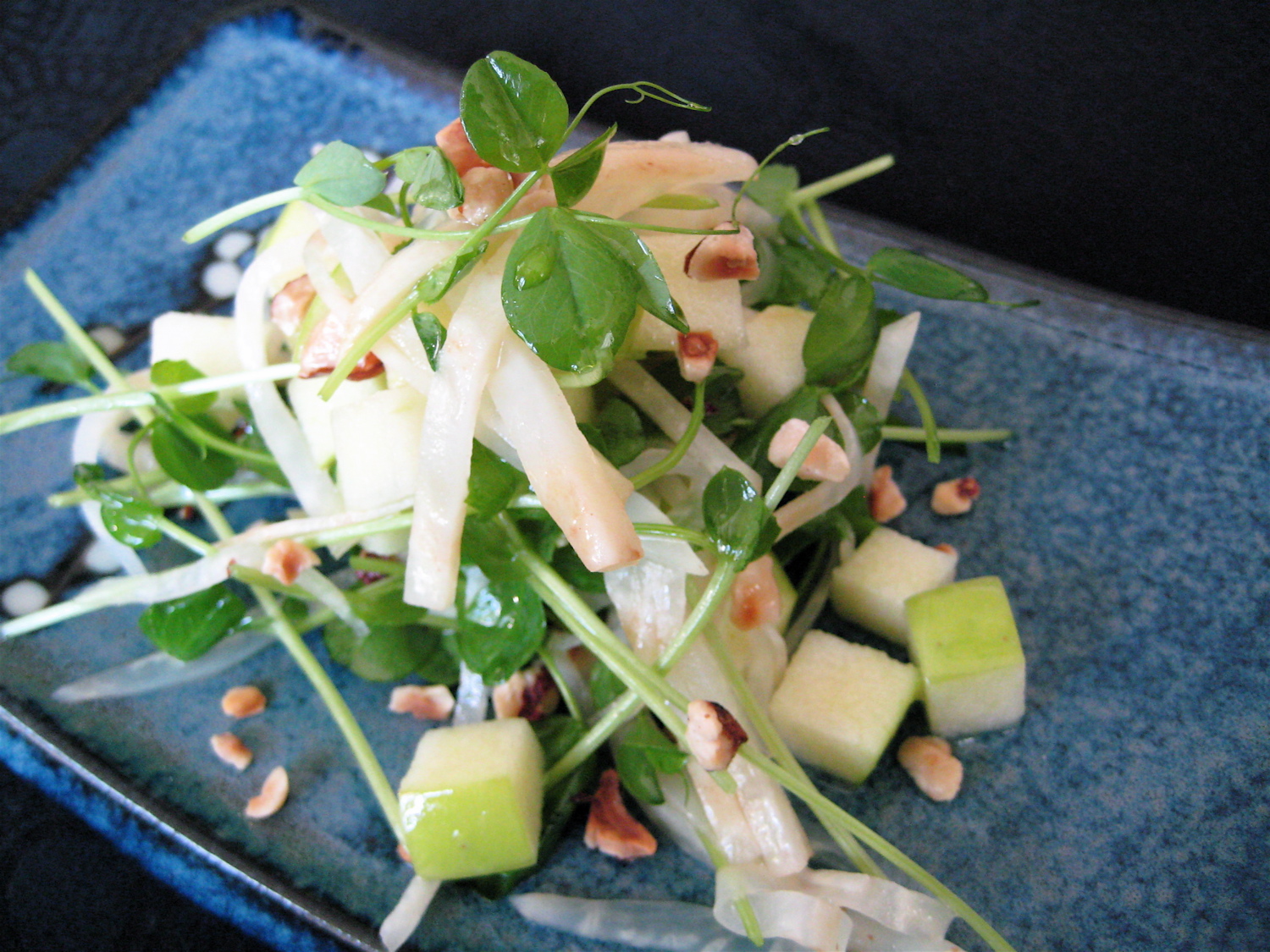 One of the toughest parts of eating almost exclusively locally in Upstate, NY, is the lack of bright, refreshing, crunchy, raw foods and salads in the colder months. We are overflowing in hearty carrot and squash soups, but there are definitely days I would kill for the snap of a thick slice of fresh cucumber. This week, particularly with the few amazing days of spring-promised sunshine we've had, I was already dreaming of getting started on my gardens, and craving some food of much warmer months. I did, however, gather at the farmer's market a collection of ingredients that came together for a great salad. When tested on my husband, the review was-- "Refreshing!". Perfect. 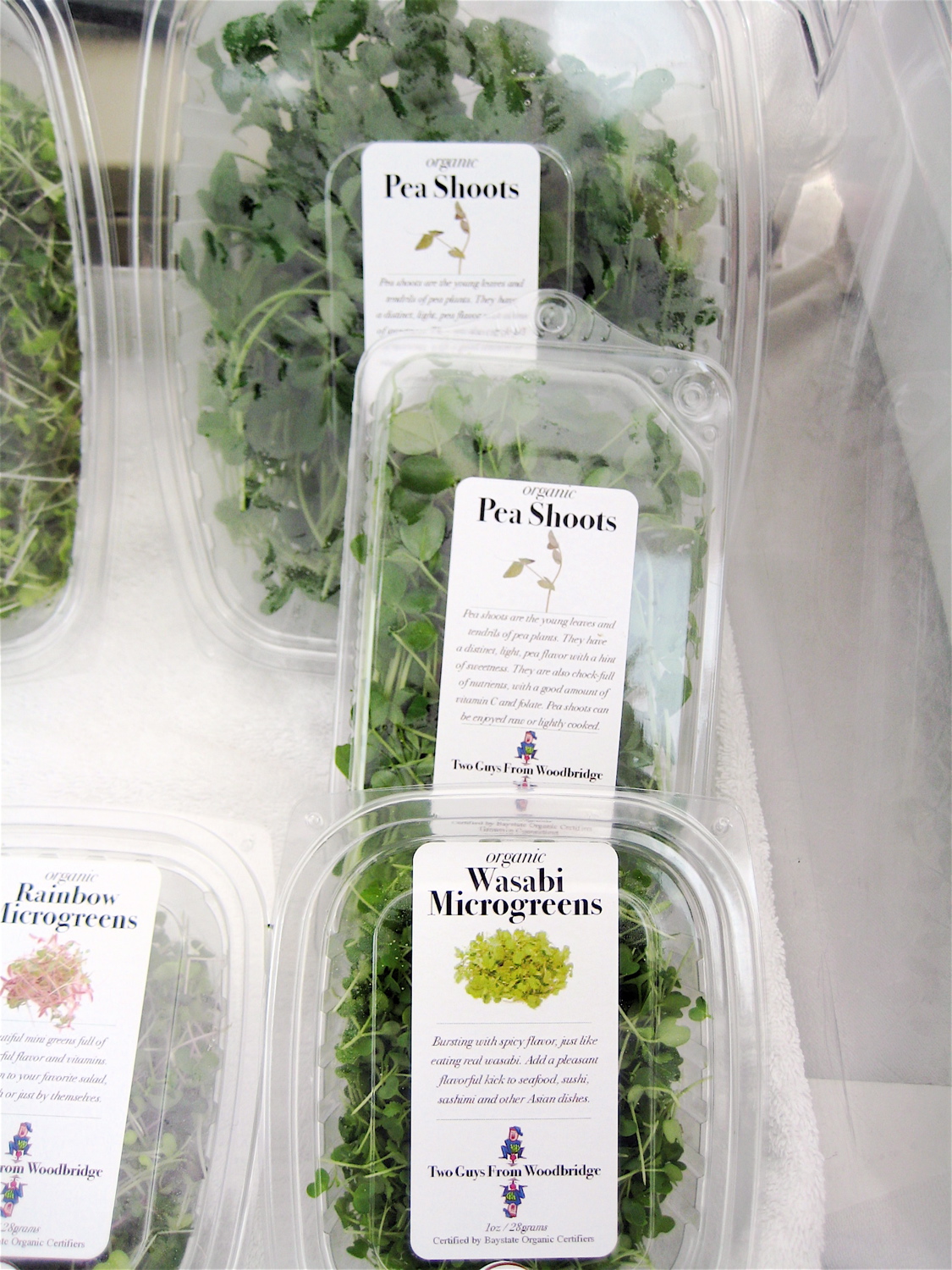 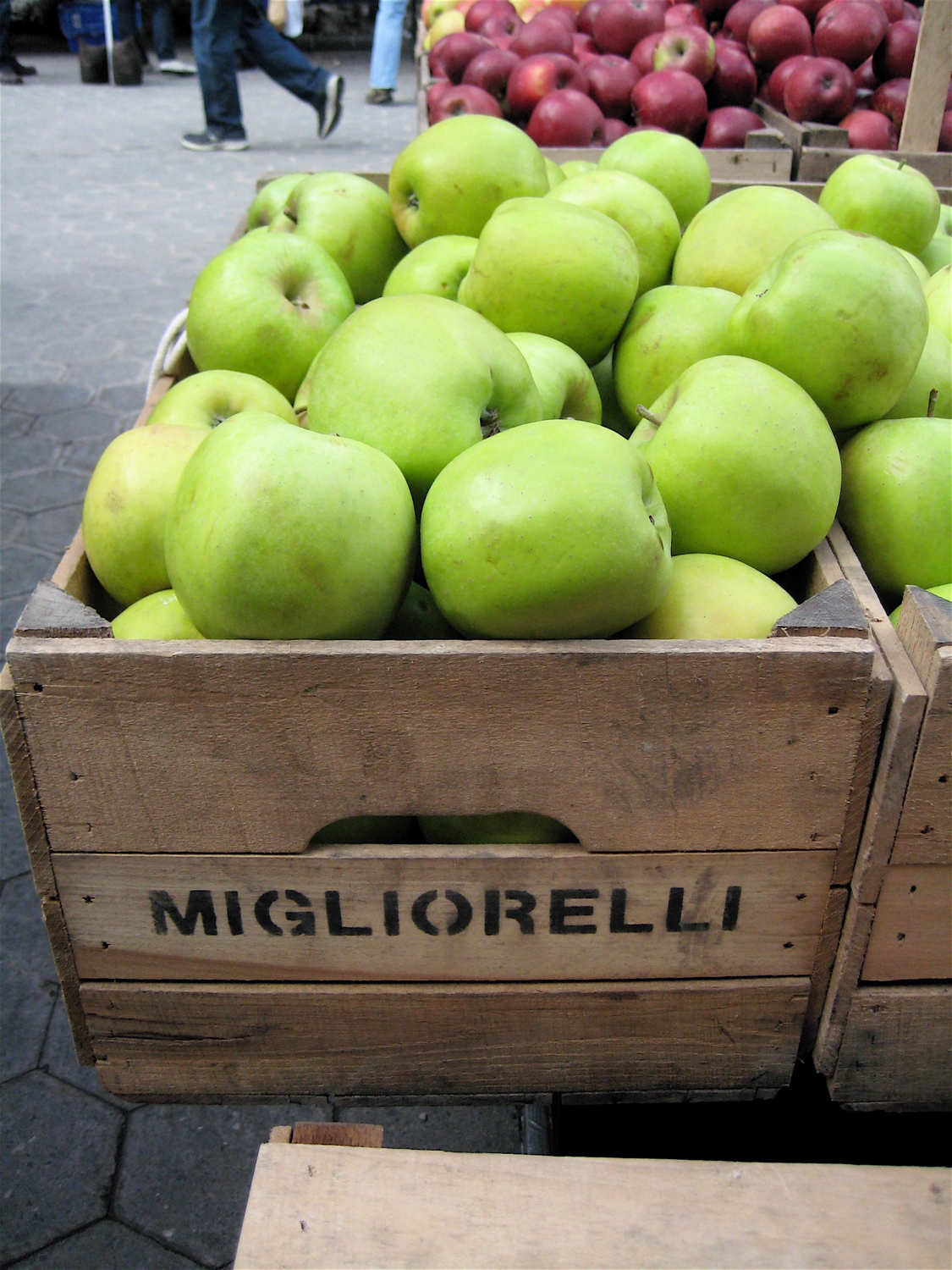 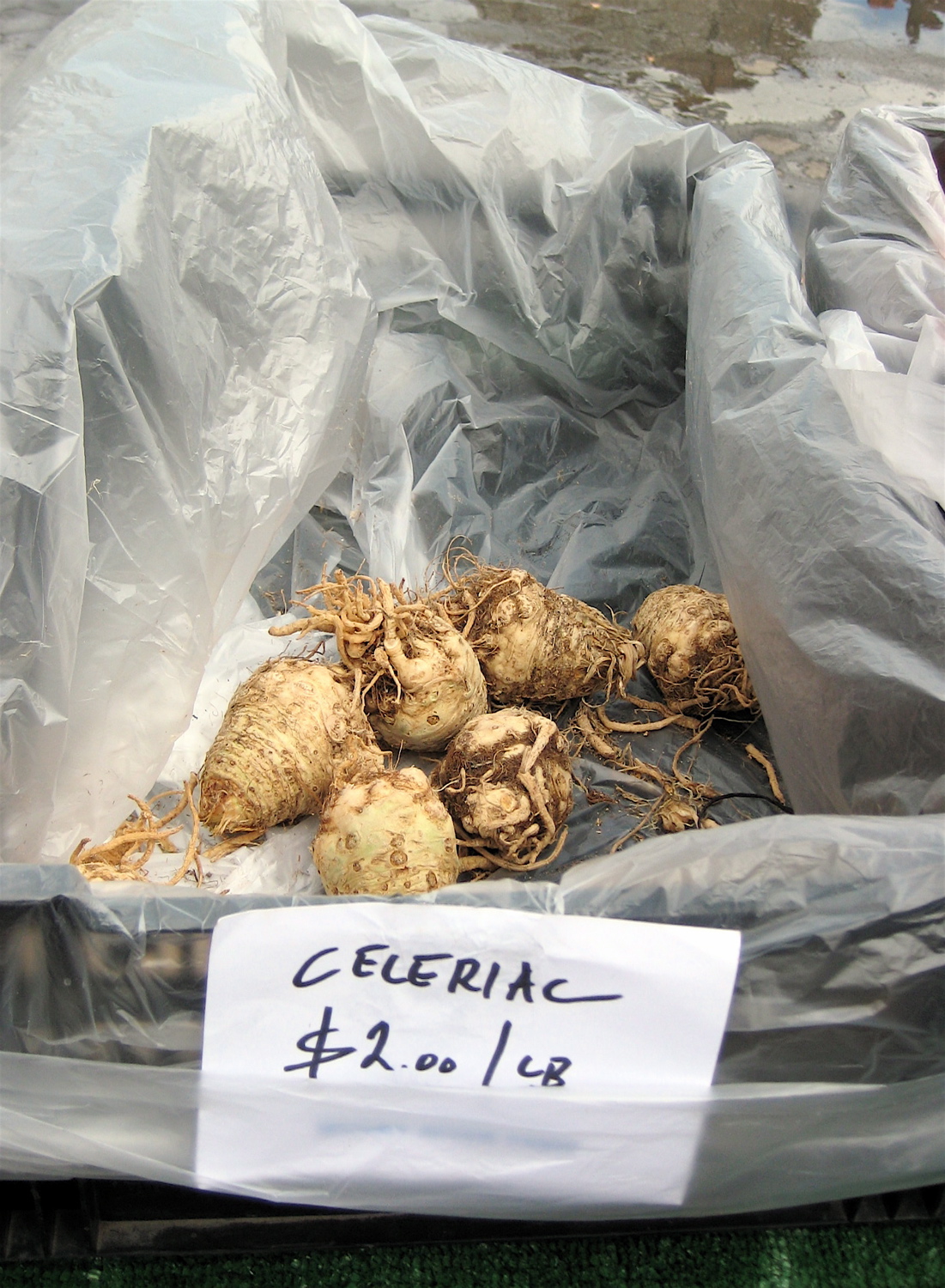 PEA SHOOT, CELERIAC, APPLE AND HAZELNUT SALAD by Catie Serves 4 2 large tart green apples (I used Mutzu apples from Migliorelli Farm) 1 medium celeriac (from Muddy River Farm in Goshen, NY) Medium handful of pea shoots, about 1 oz (from Two Guys from Woodbridge hydroponic farm, in Hamden, CT) 1/4 cup toasted and chopped hazelnuts for the dressing: 1 tsp apple cider vinegar 1 TBS hazelnut oil salt and pepper to taste. Cut the rough exterior off the celeriac, and cut the inner white part into thin matchsticks. Bring a pot of salted water to a boil. Have ready a bowl of ice water. When water is boiling, put in cut celeriac and blanch until al dente, about 30 seconds, depending on the size of the pieces. Immediately scoop out with slotted spoon and shock in ice water. Drain and dry. Cut apples in small cubes. Wash and dry pea shoots. Put cider vinegar in large bowl. Slowly add hazelnut oil in thin stream while whisking constantly. Season with salt and pepper. Add celeriac, apple, pea shoots, and hazelnuts to bowl. Toss with vinaigrette. Gently mound salad on a plate. Sprinkle top with a few more nuts. 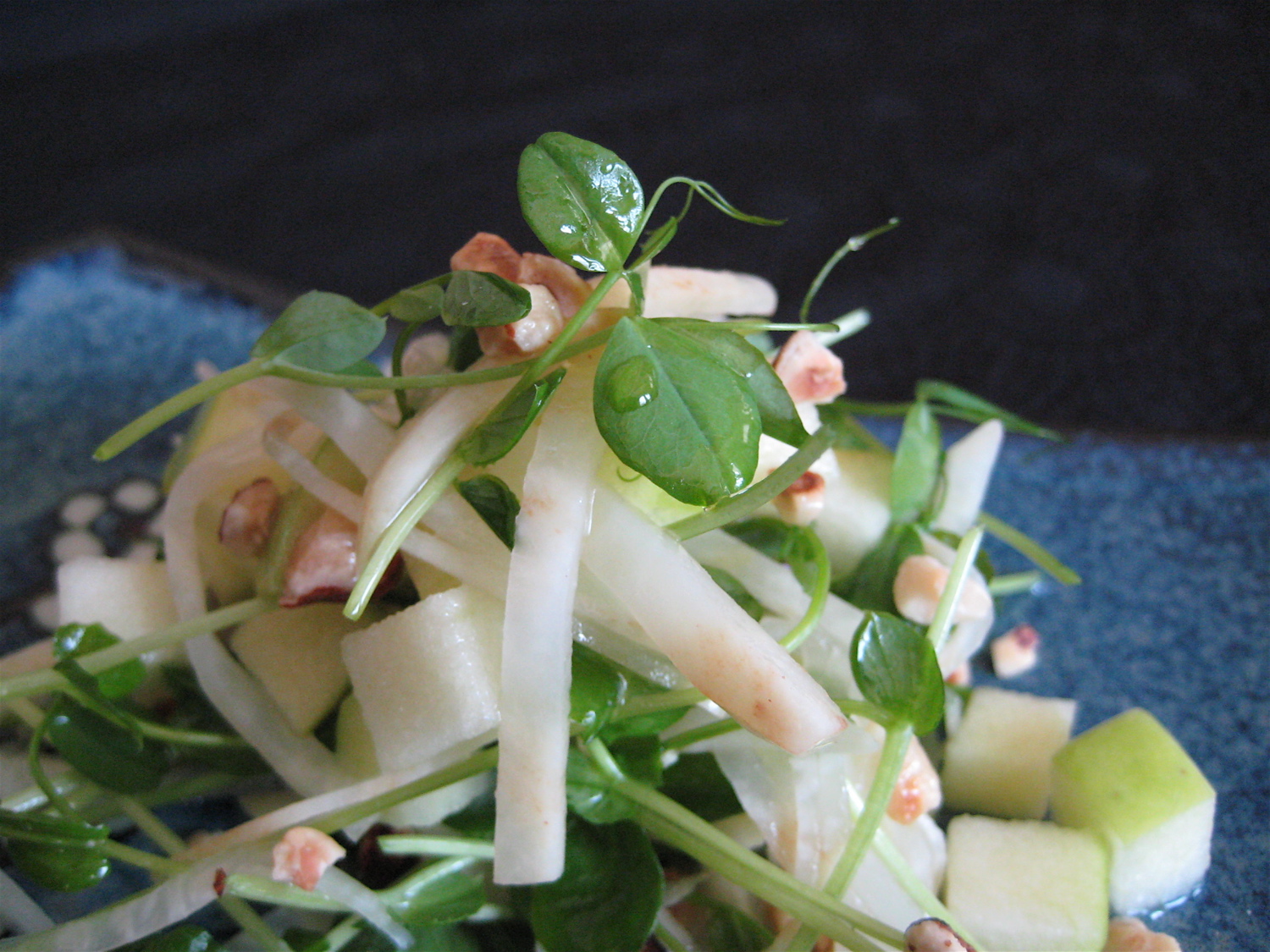 | ||||||||||||||||
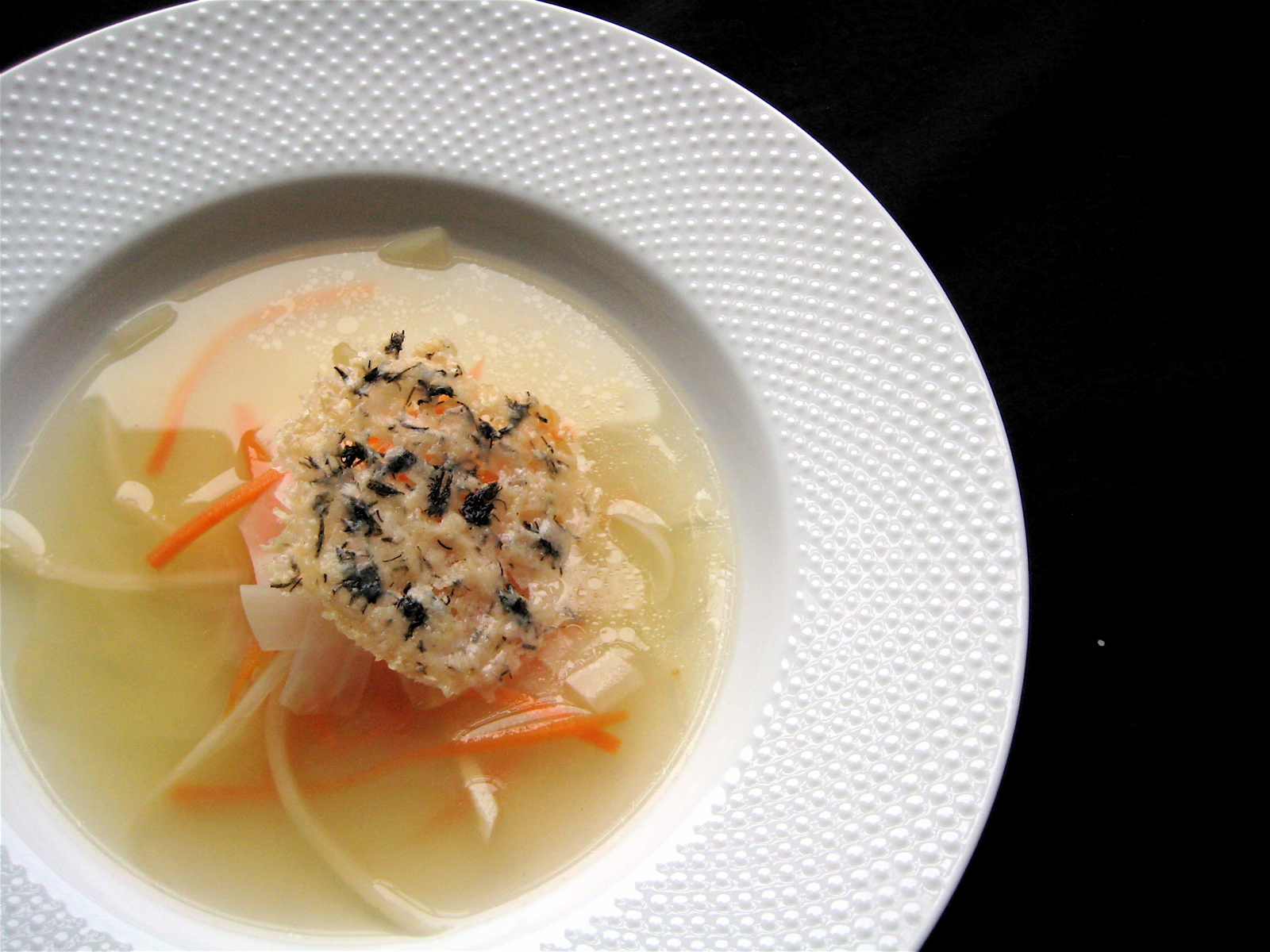 After the 3+ feet of snow we had this past week, I find it impossible to believe that I am watching even more flurries outside today. The blizzard this week caused the farmers, whose work ethic is only outdone by their good sense, to not come to NYC for the greenmarket this Friday. Union Square, though stunning all decked out in white, was empty. Fortunately last week I bought a lot of long-keeping root vegetables. Perfect tools for a shut-in day upstate, with no takeout around for miles. 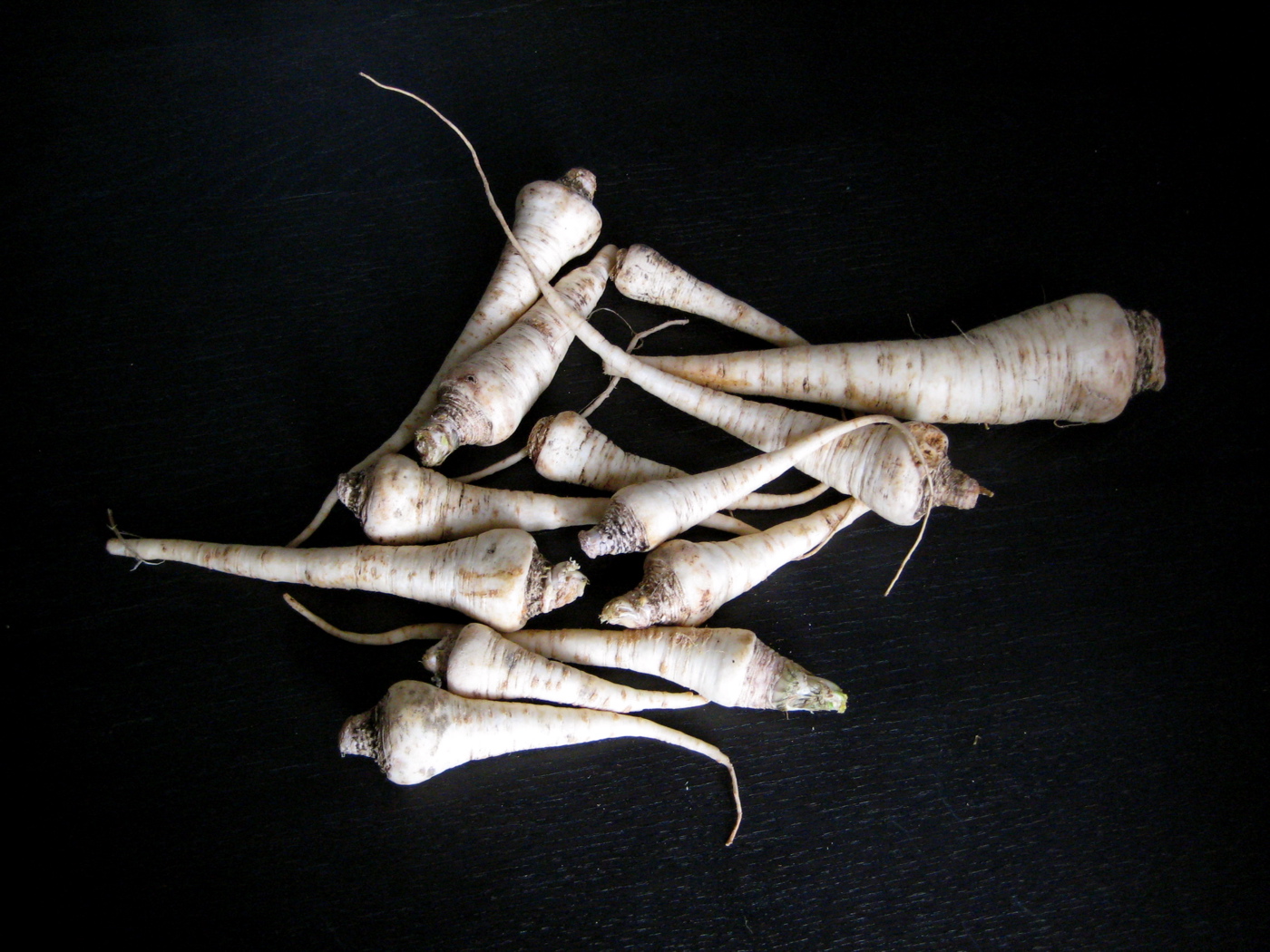 WINTER CHICKEN “NOODLE” SOUP WITH DILL PARMESAN CRISPS By Catie Serves 4 For the Soup: 2 quarts Chicken Stock 1 medium Celeriac, about 6 oz, peeled and shredded or sliced thin 2 medium Parsnips, about 6 oz, peeled and shredded or sliced thin 3-4 Carrots, about 6 oz, peeled and shredded or sliced thin salt to taste For the Crisps: 1 packed cup Parmesan Cheese, grated 1 tsp Fresh Dill, finely chopped (I used dill I had frozen from our garden this summer) For the Crisps: Preheat oven to 350° F. Thoroughly mix grated parmesan and fresh dill together in a small bowl. Make small mounds (about 2 TBS each) of the cheese mixture evenly spaced on a silpat mat on a sheet pan. Gently flatten each mound into a disc shape—the cheese won’t spread much beyond where you place it. You should have about 6 discs. 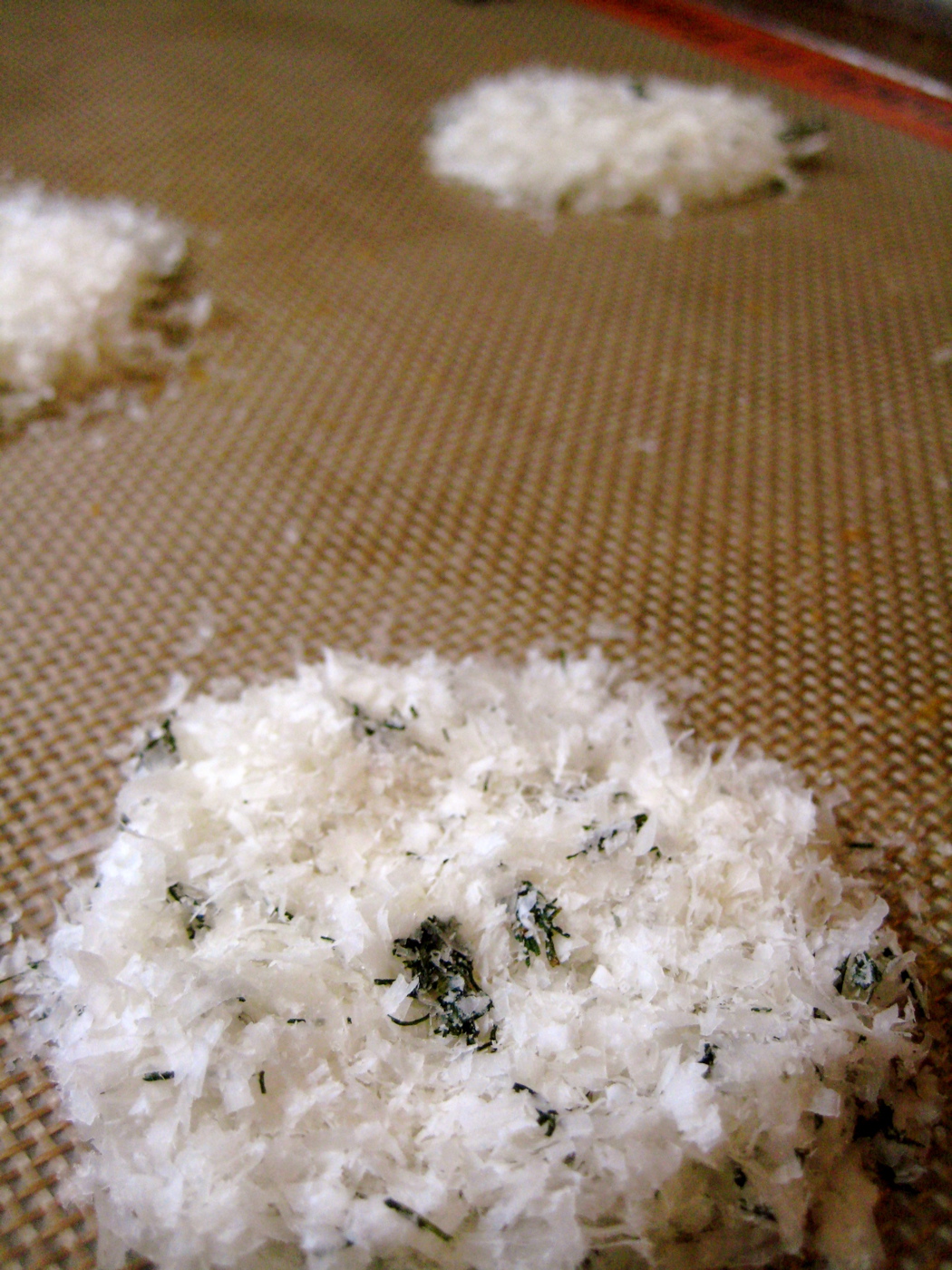 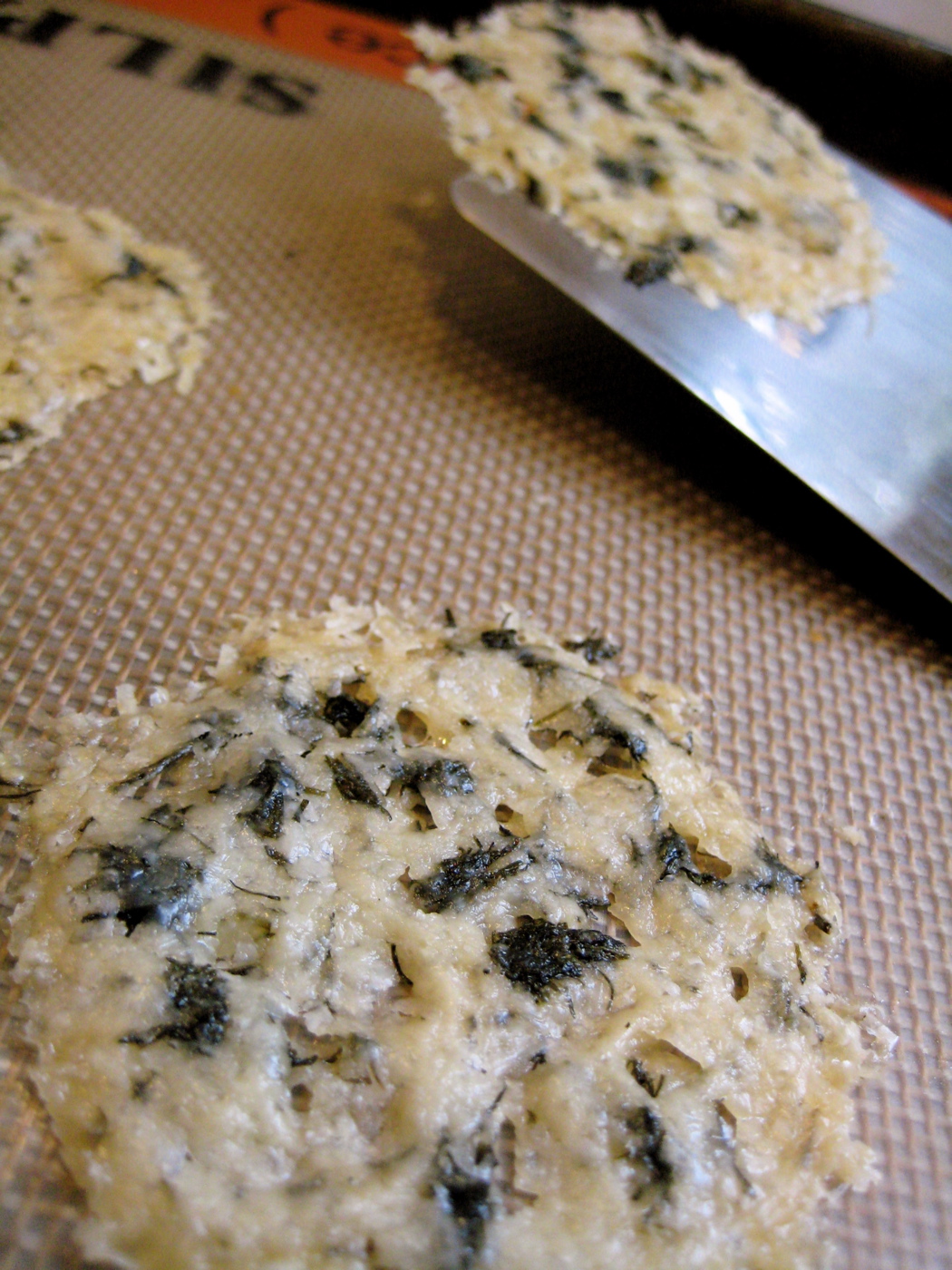 Bake at 350° F for about 8 minutes—just until the melted cheese has reached the center of the discs, and the edges are just starting to turn golden. Don’t over cook, or they tend to get bitter. Let the crisps cool on the silpat. Gently remove with a thin spatula. For the Soup: 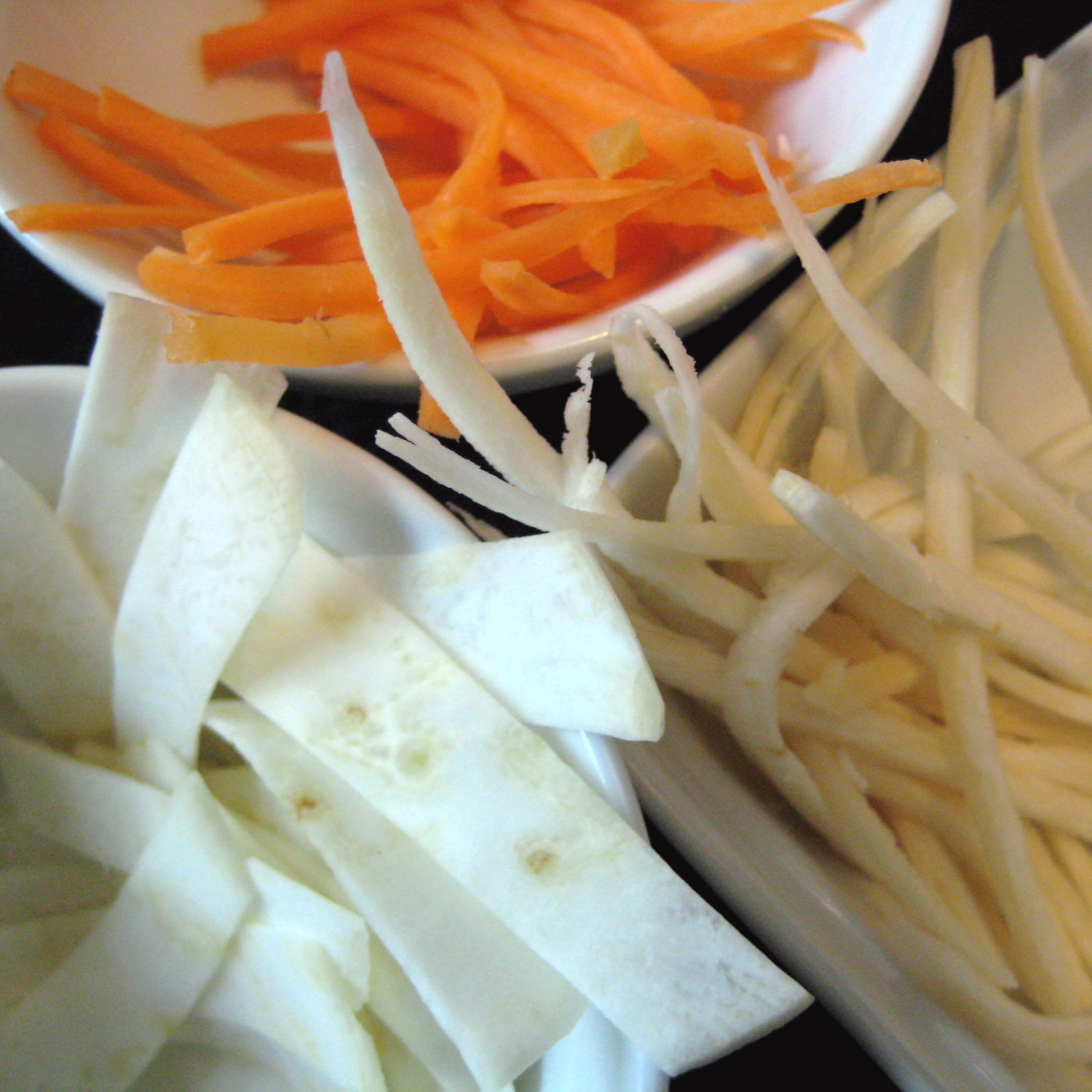 The vegetables can be cut in a variety of ways. The easiest is shredding them all in the food processor with the large grating blade. However, you can also use a mandoline for long thin strips, julienne them by hand, or (as I did with the celeriac this time) thinly slice with a vegetable peeler—which ended up looking the most like noodles. It is pretty to slice them in a few different ways, particularly if you have two vegetables that are the same color. The vegetables can be cut in a variety of ways. The easiest is shredding them all in the food processor with the large grating blade. However, you can also use a mandoline for long thin strips, julienne them by hand, or (as I did with the celeriac this time) thinly slice with a vegetable peeler—which ended up looking the most like noodles. It is pretty to slice them in a few different ways, particularly if you have two vegetables that are the same color.(The most important thing is to make sure that all the vegetables are relatively similar in thickness once they are cut, so they cook evenly. You can certainly stagger putting them into the pot if you have larger cuts, so they can all be finished at the same time.) Heat the chicken stock over medium heat to a gentle boil. Add the shredded vegetables. Bring the stock back to a boil, and reduce to a simmer until the vegetables are al dente—about 4 minutes total. Season with salt to taste. Portion into four bowls, and mound vegetables slightly in the center. Top with a Dill Parmesan Crisp. 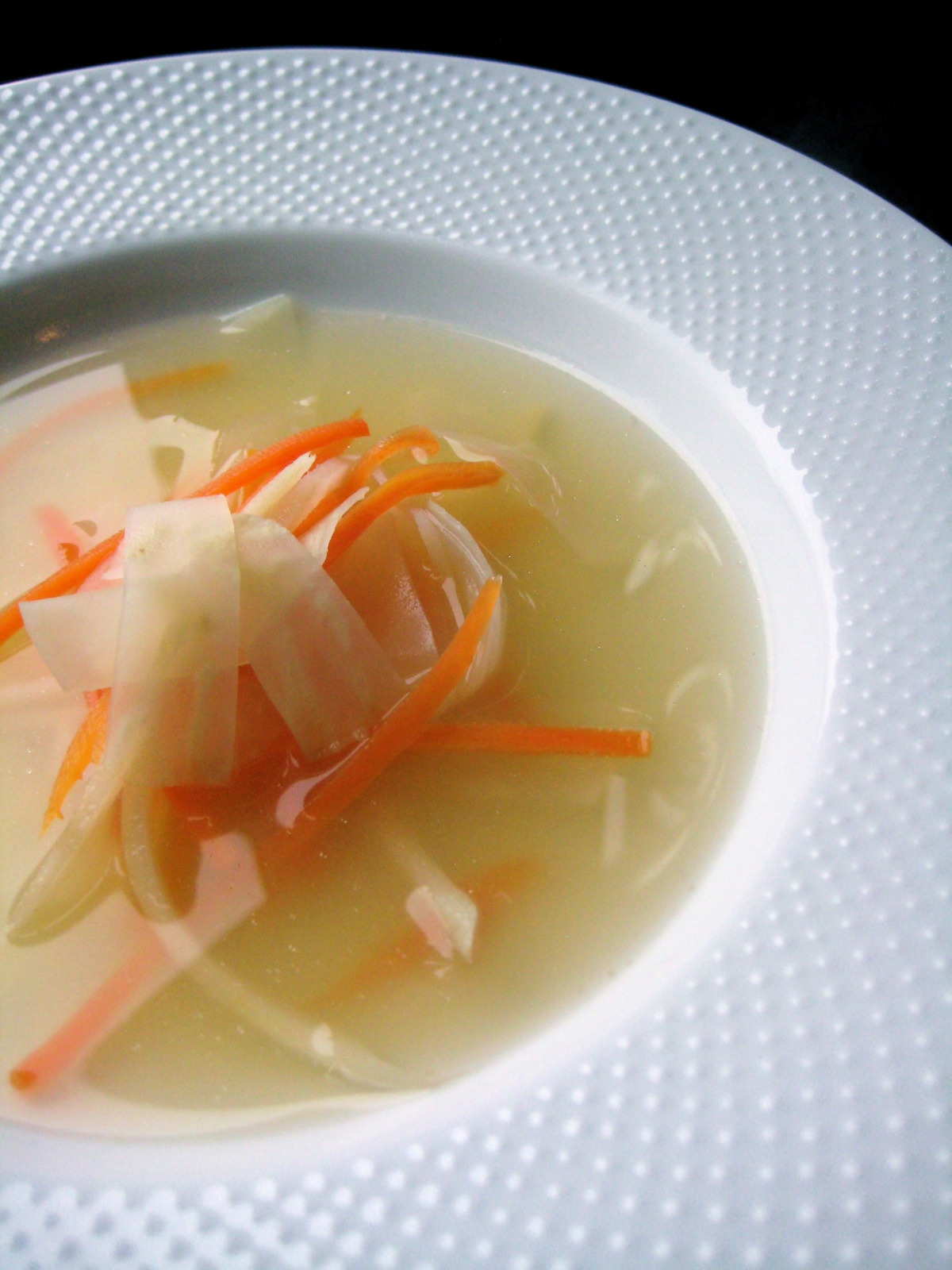 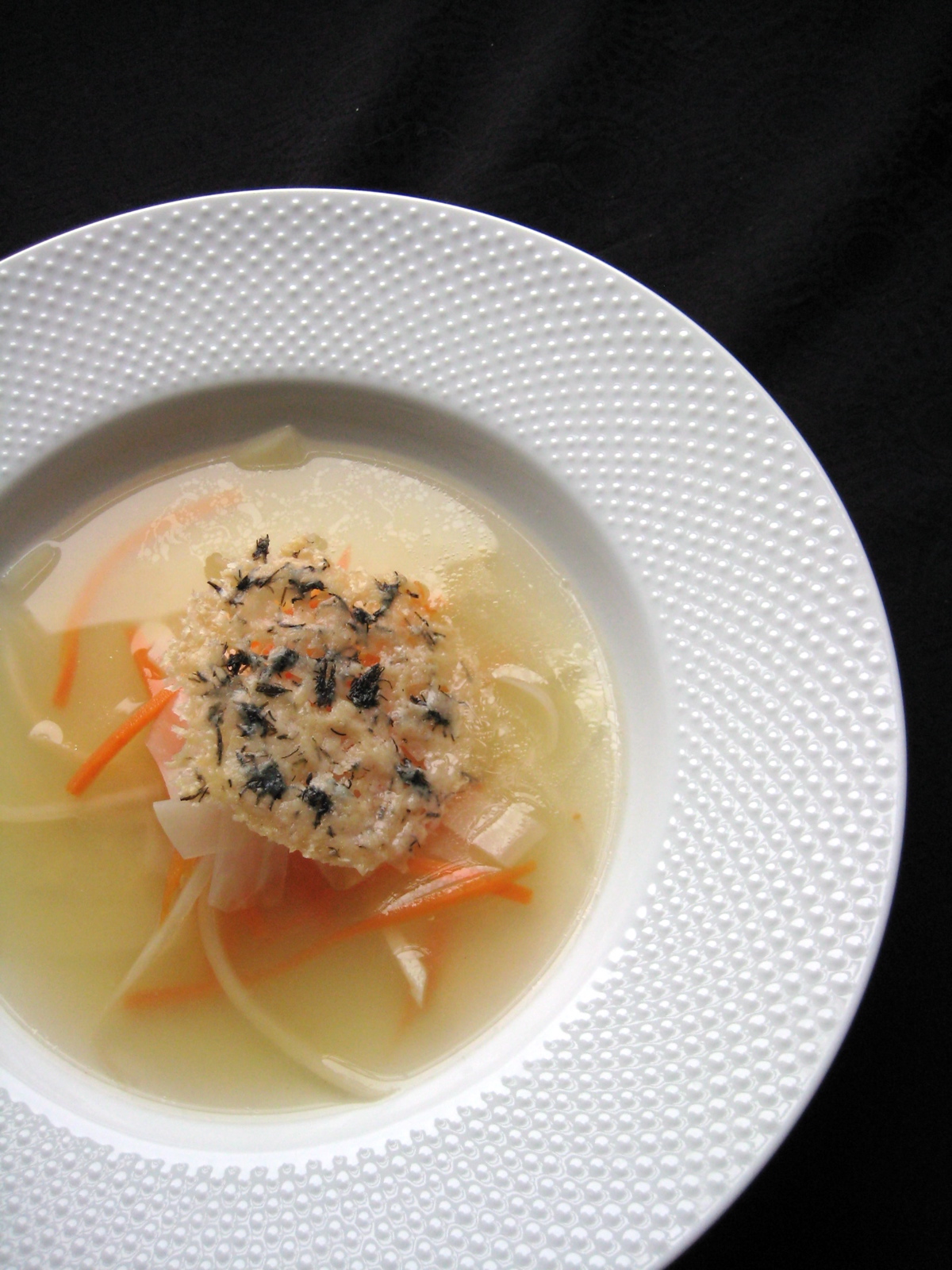 | ||||||||||||||||
|
{ welcome! }
 Catie Baumer Schwalb is a chef, food writer and photographer, who splits her life between the city and the country. Not too long ago Catie was a New York City based actress and playwright for more than a decade. She has her Master of Fine Arts from the National Theater Conservatory, and her Grand Diplôme in classic culinary arts from the French Culinary Institute in New York City.
... Read More ≫
Catie Baumer Schwalb is a chef, food writer and photographer, who splits her life between the city and the country. Not too long ago Catie was a New York City based actress and playwright for more than a decade. She has her Master of Fine Arts from the National Theater Conservatory, and her Grand Diplôme in classic culinary arts from the French Culinary Institute in New York City.
... Read More ≫{ get in touch }
{ what's new }
September 12, 2015
August 19, 2013
August 15, 2013
August 13, 2013
August 1, 2013
{ favorites }
{ archives }
Appetizers / Breads & Pastry / Breakfast / Cakes / Canning / Condiments / Dinner / DIY foods / Drinks / Fall / favorites / Grains / Holidays / Local / Noodles & Pasta / Pies & Tarts / Poultry / Salads / Seafood / Snacks / Soup / Spring / Summer / Sweets / Techniques / Vegetables / Vegetarian / Winter /
{ currently reading }
|



